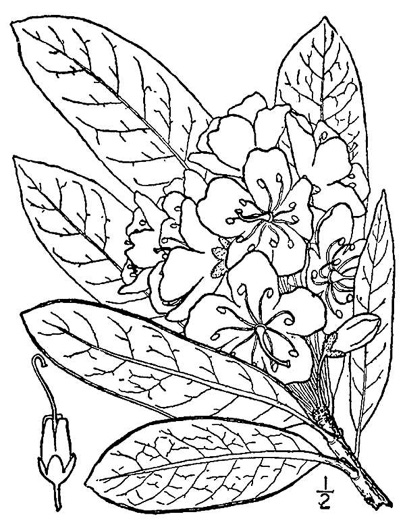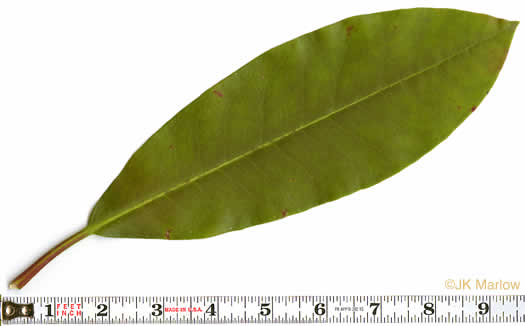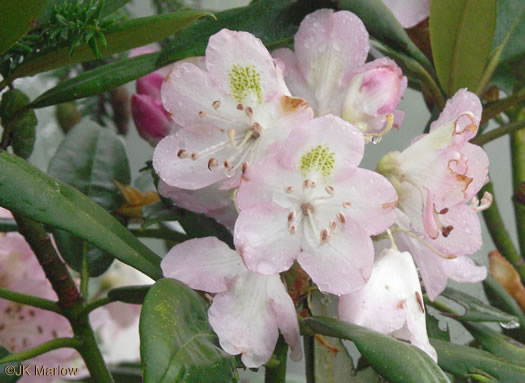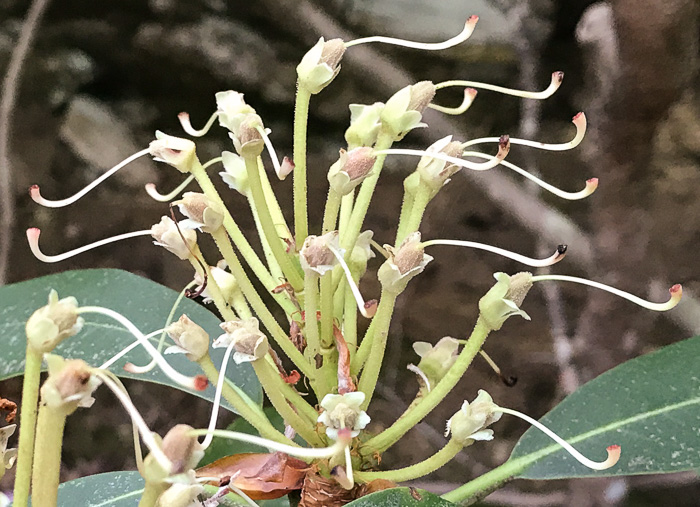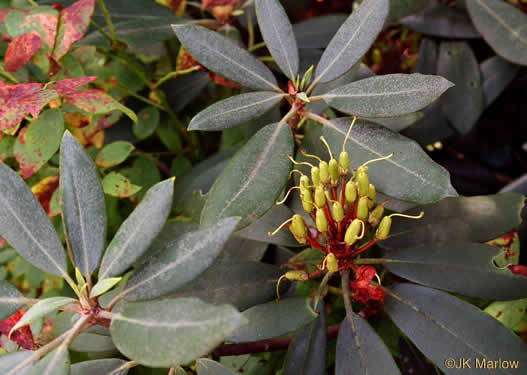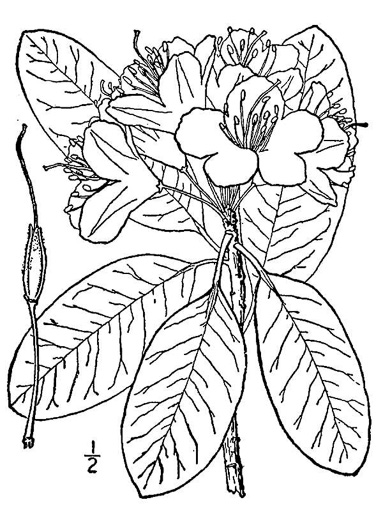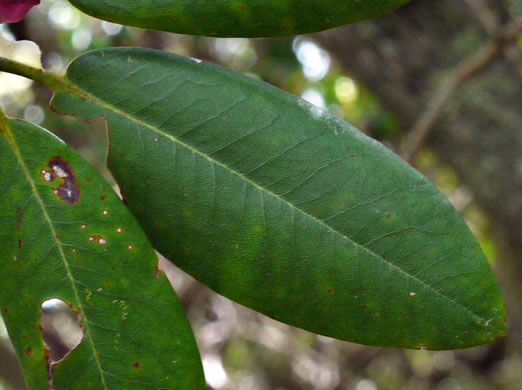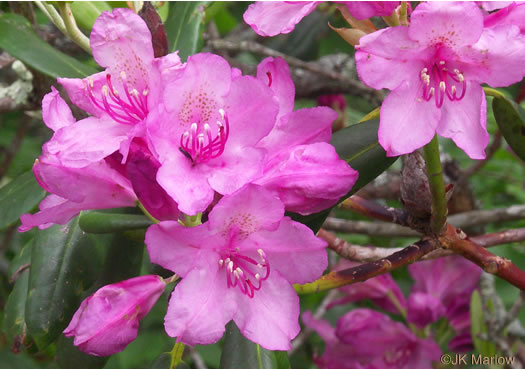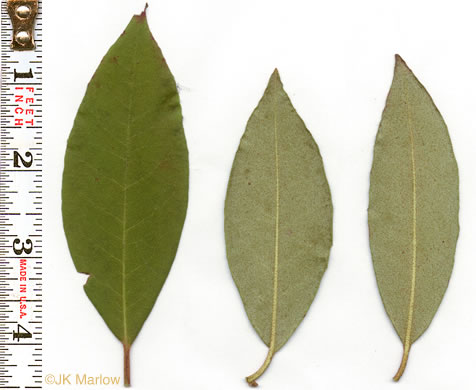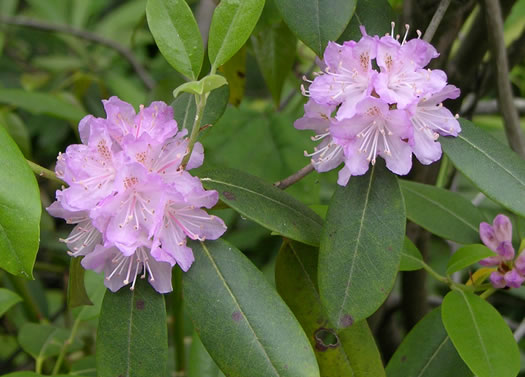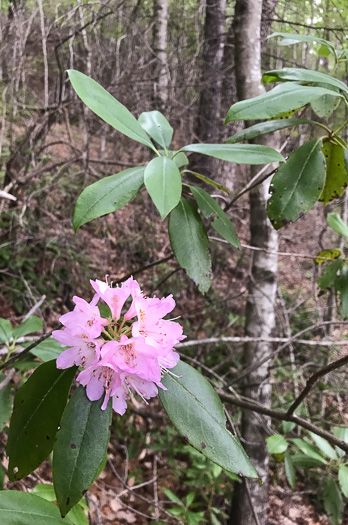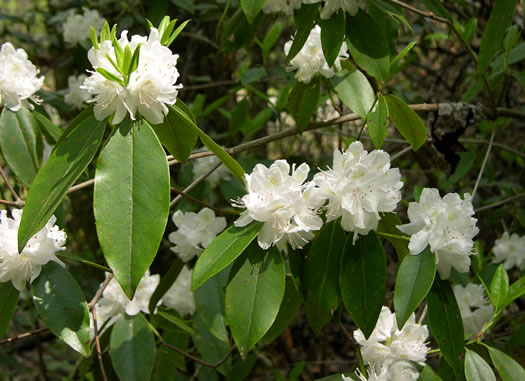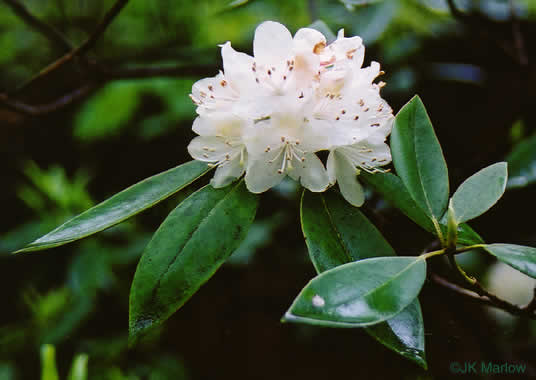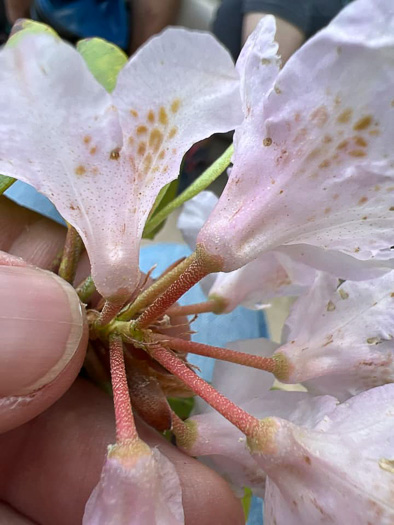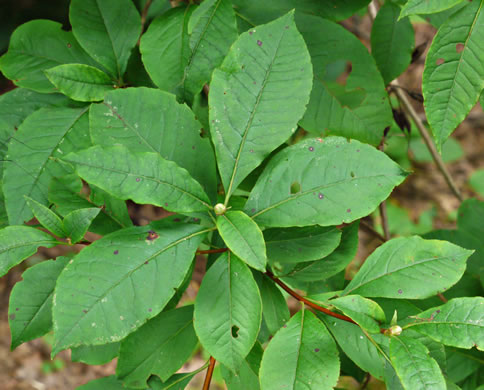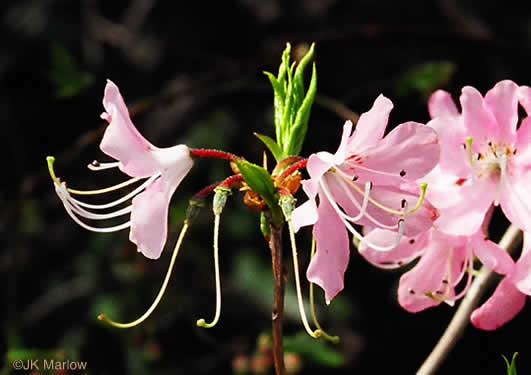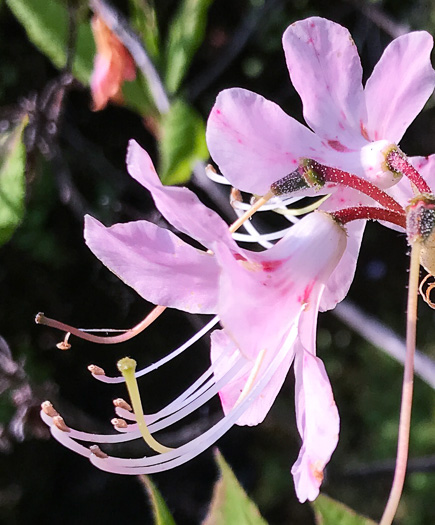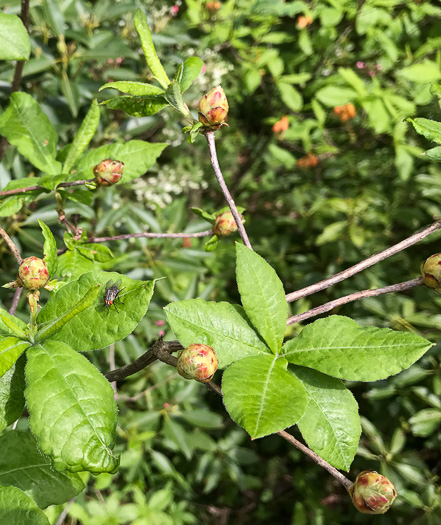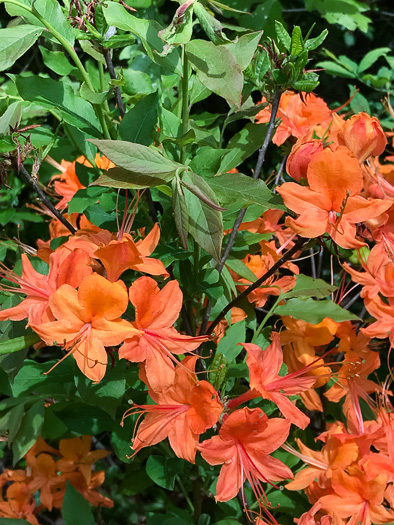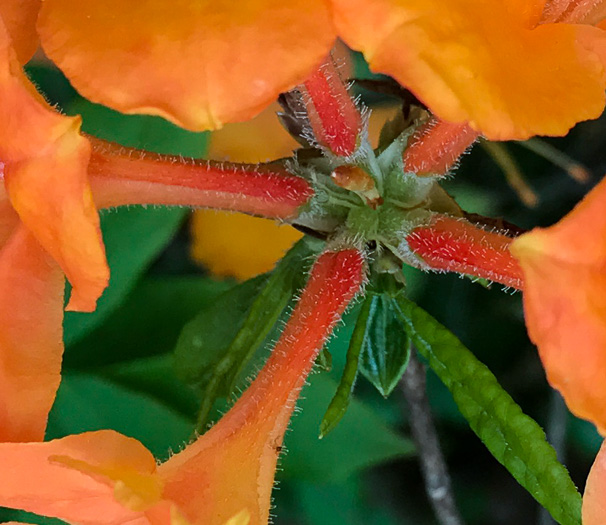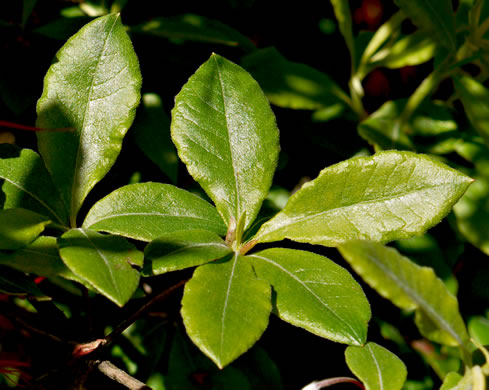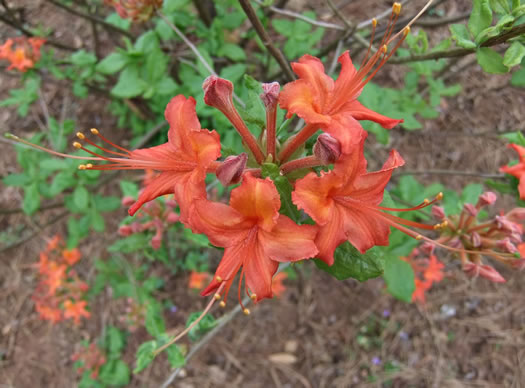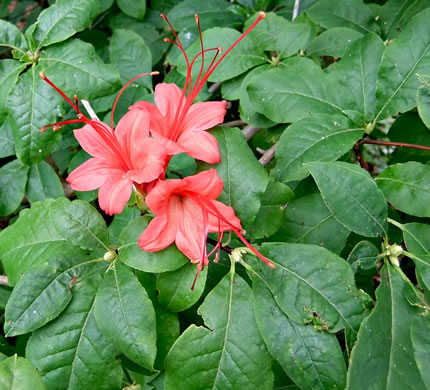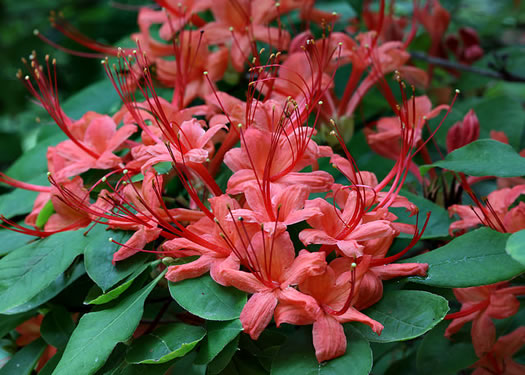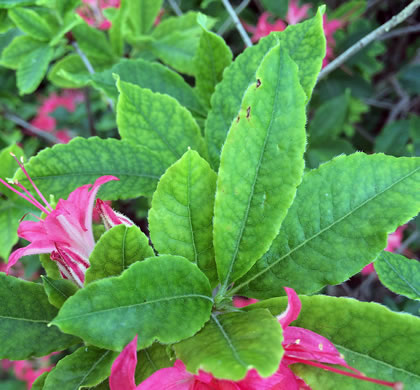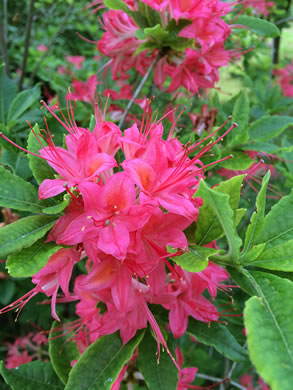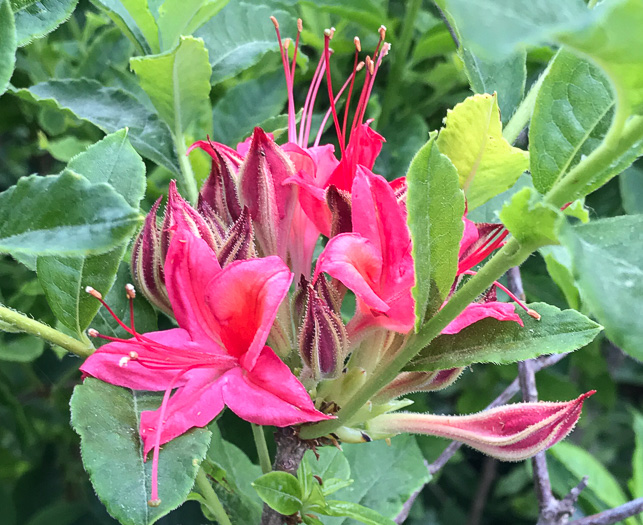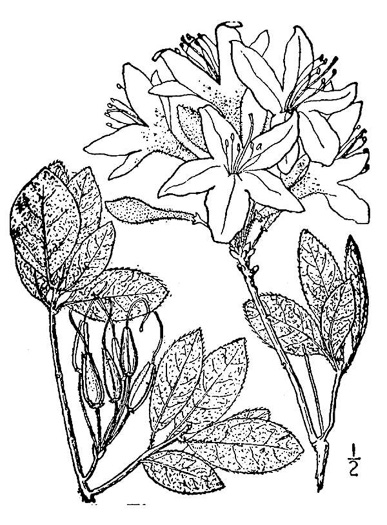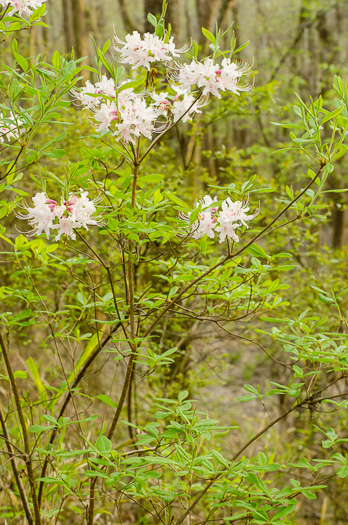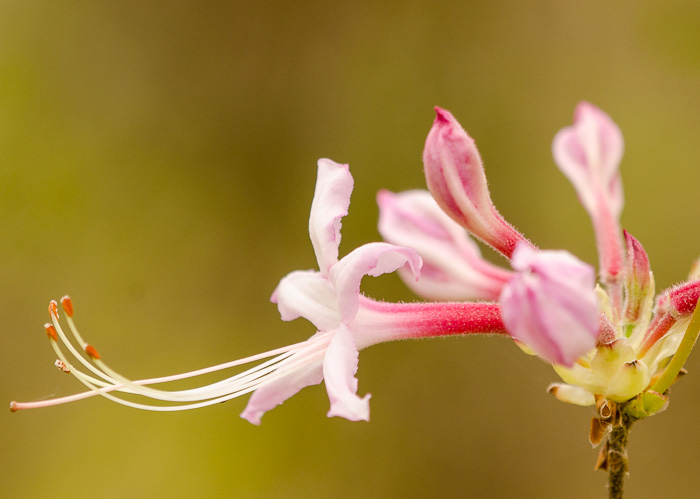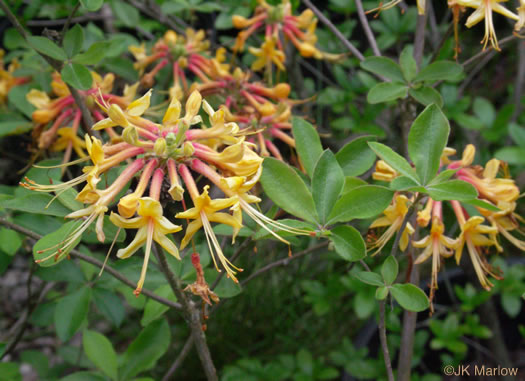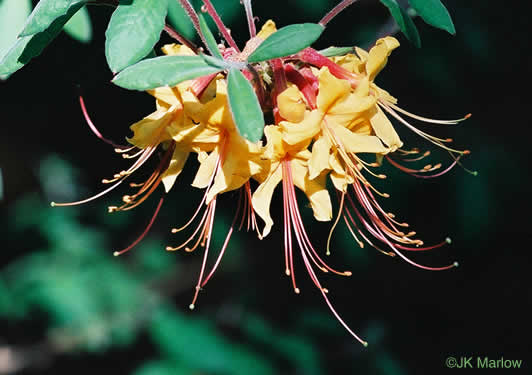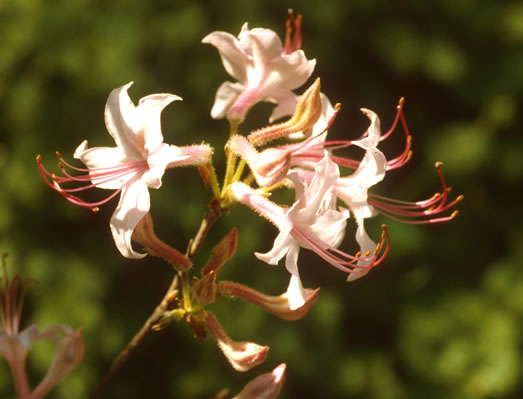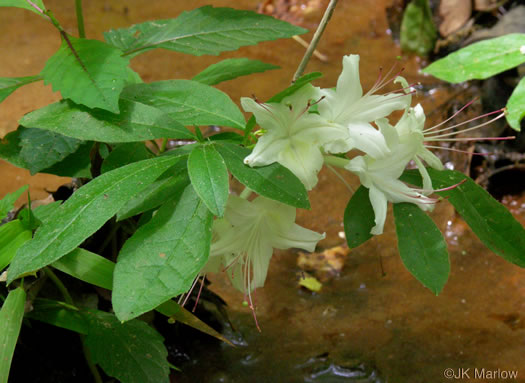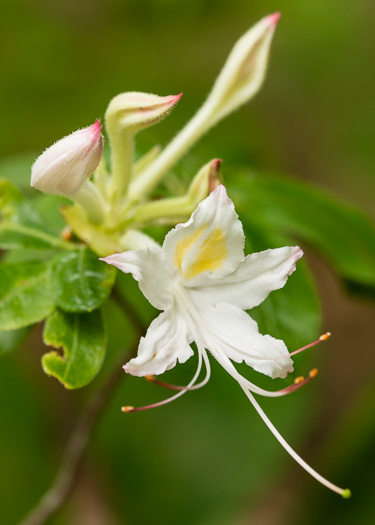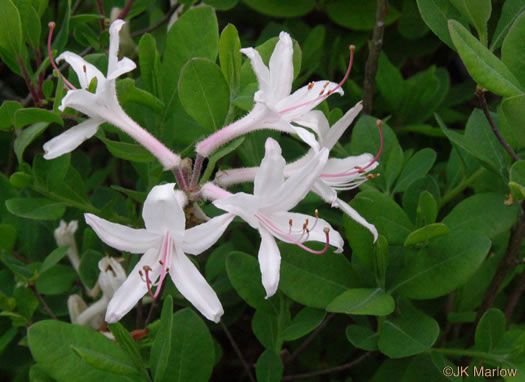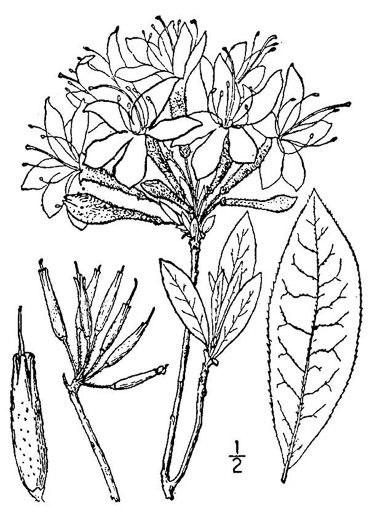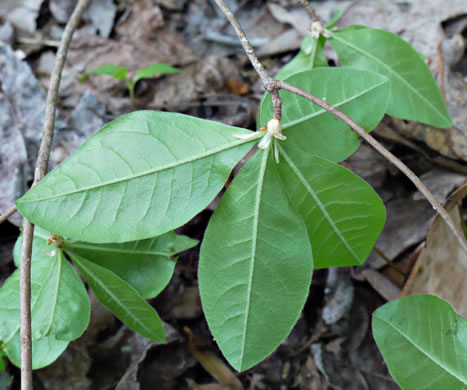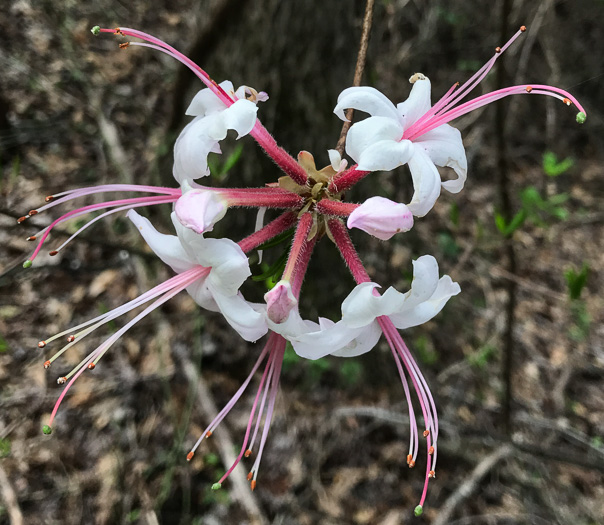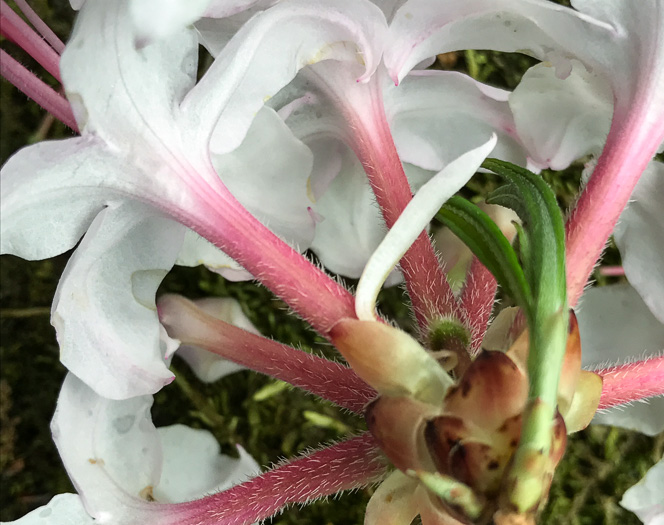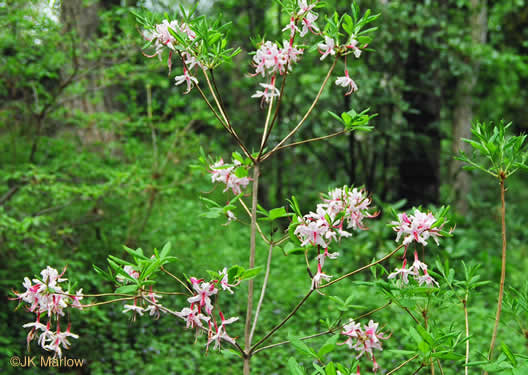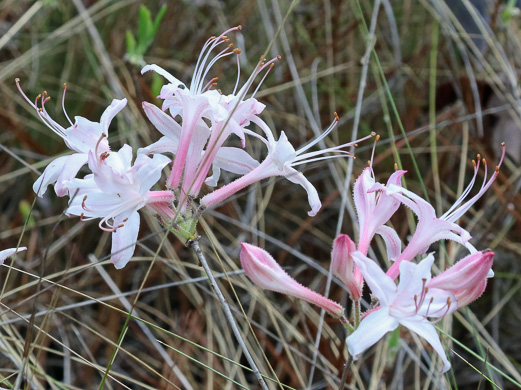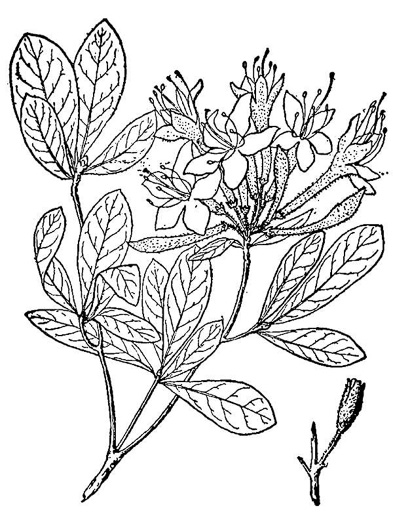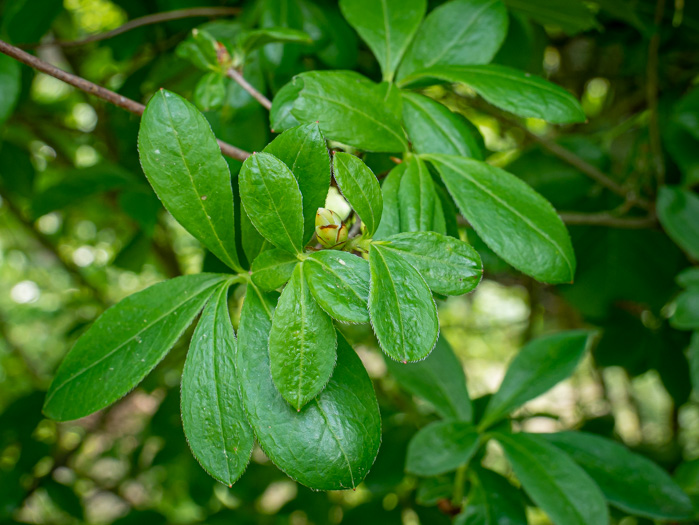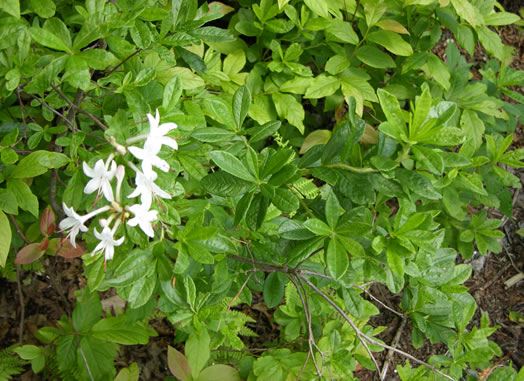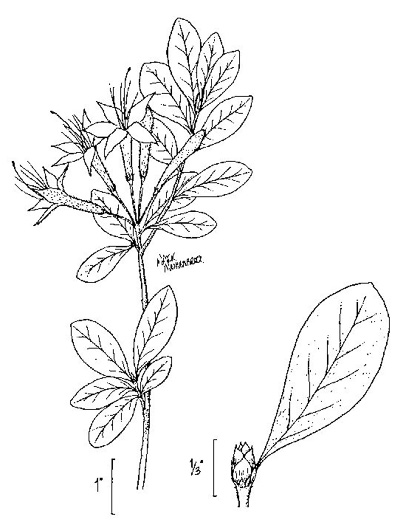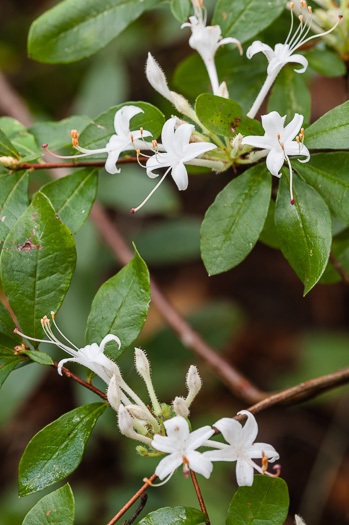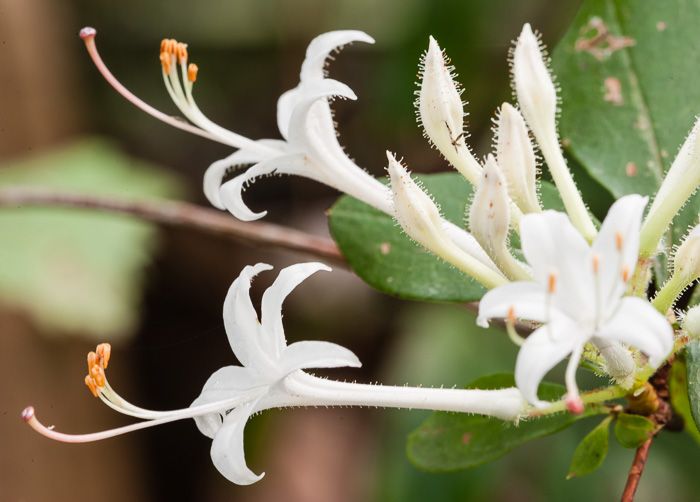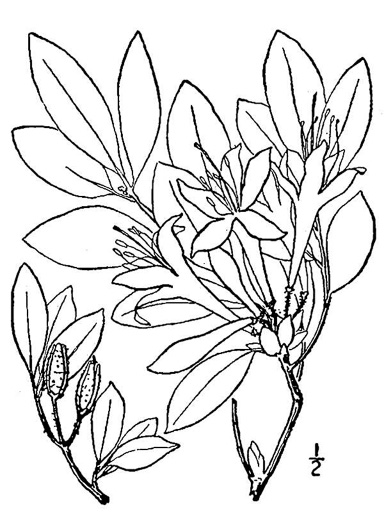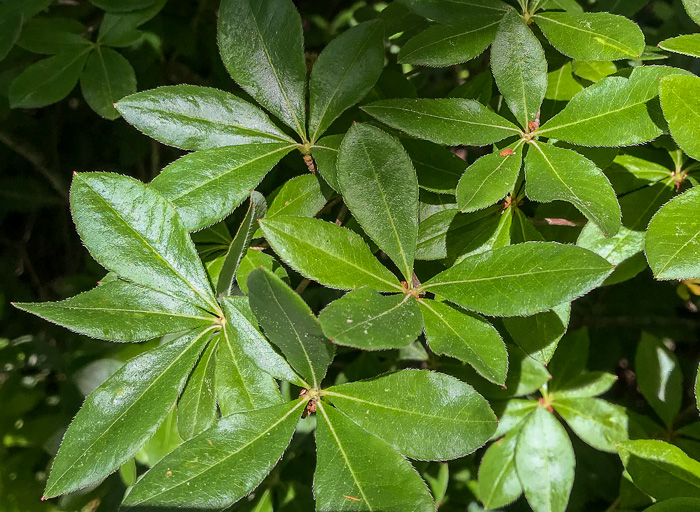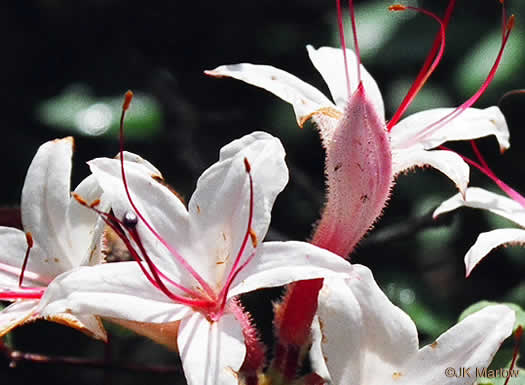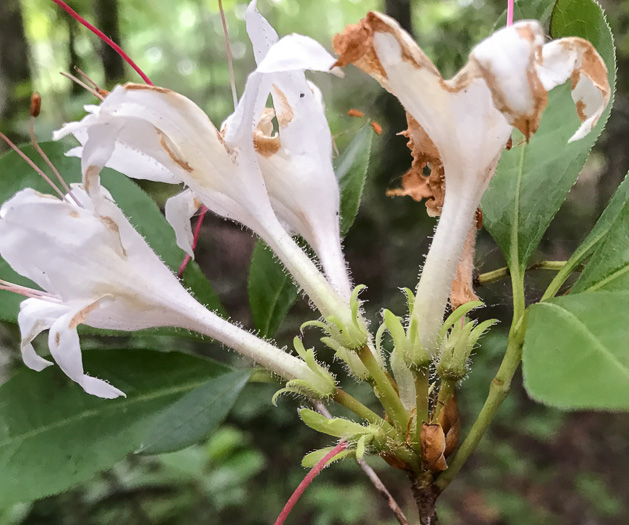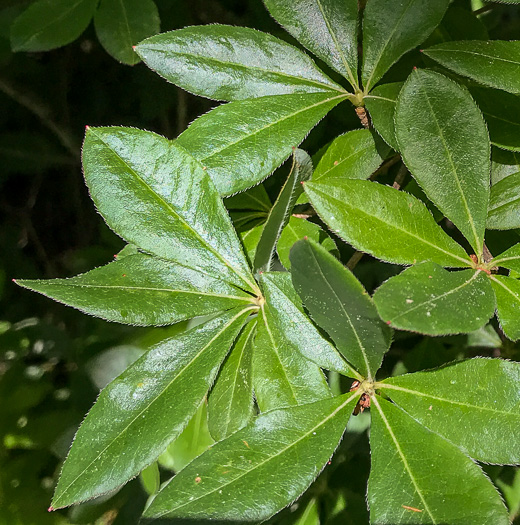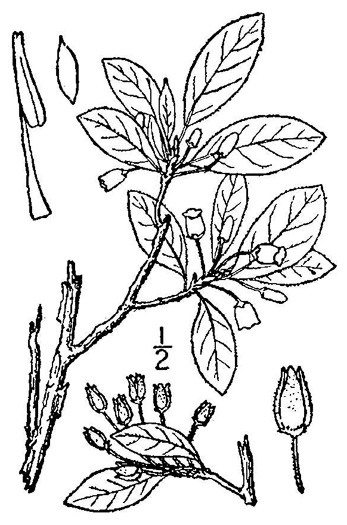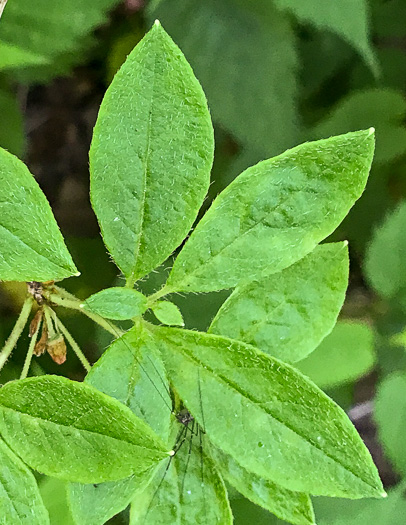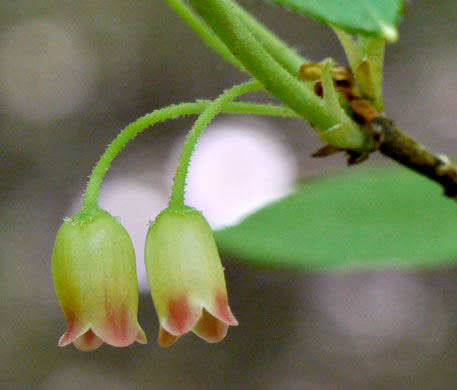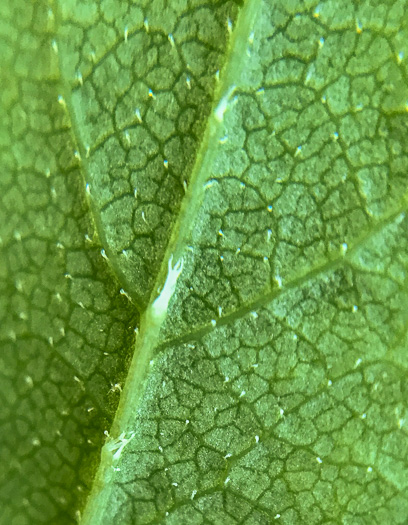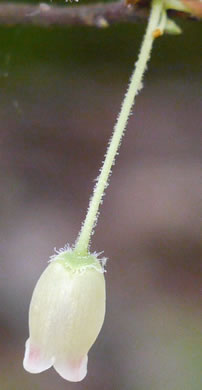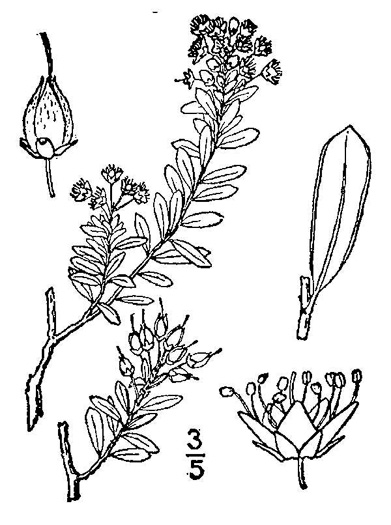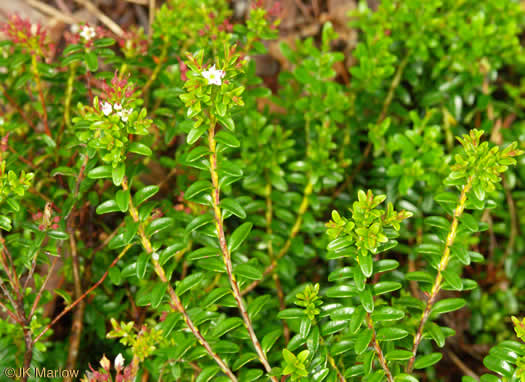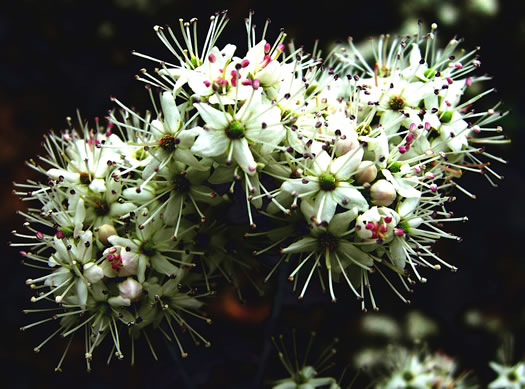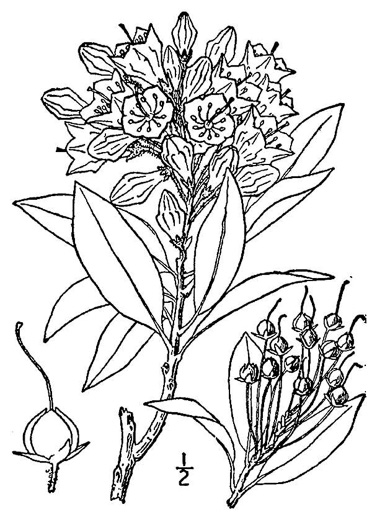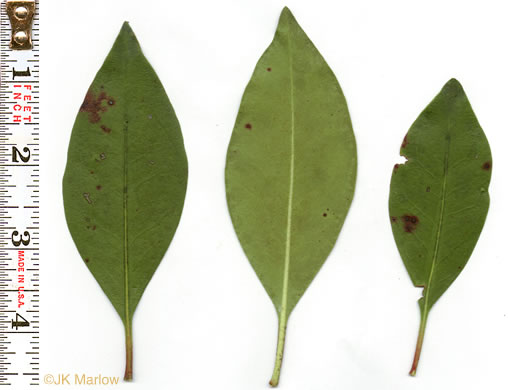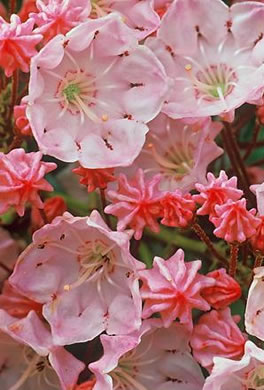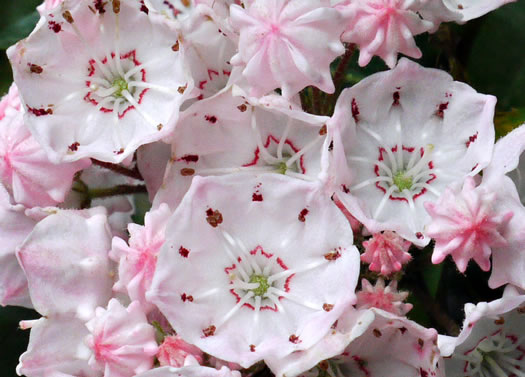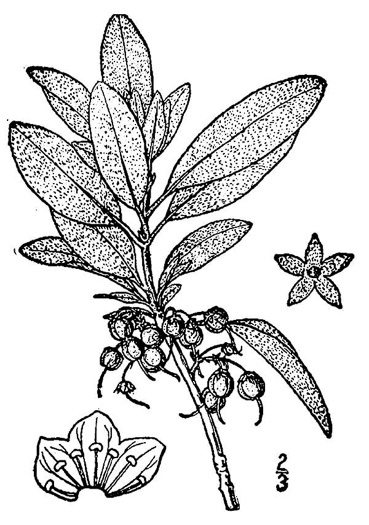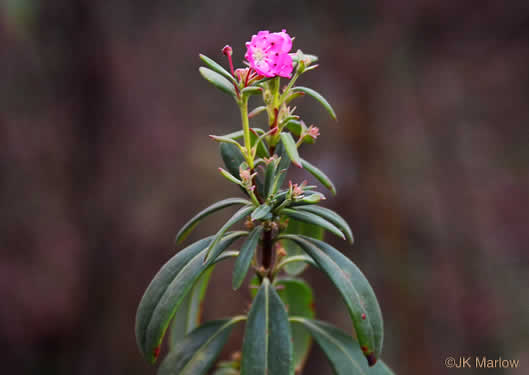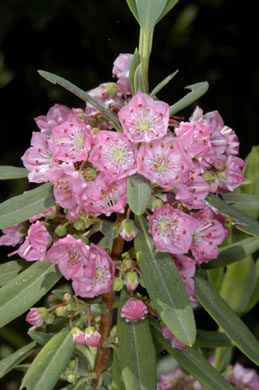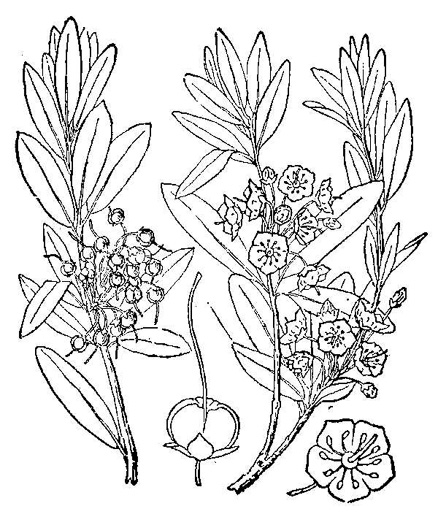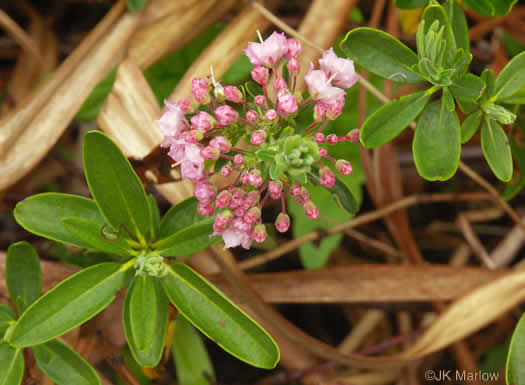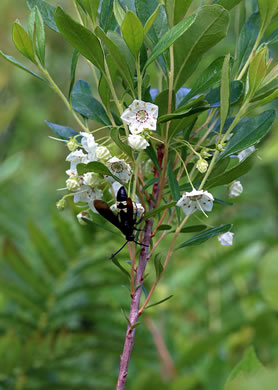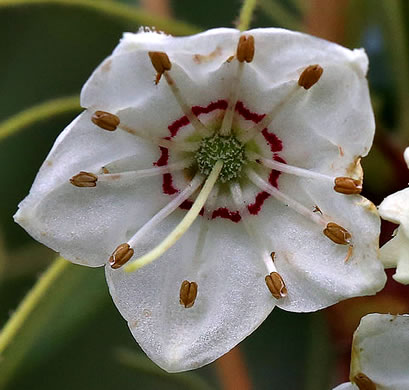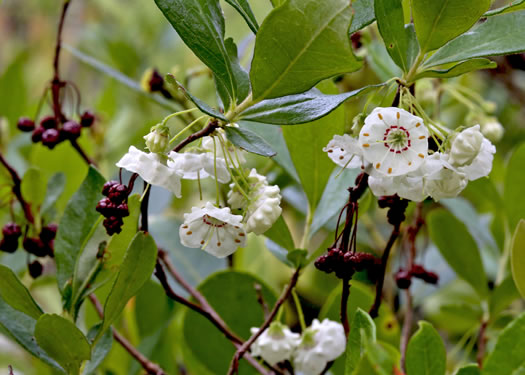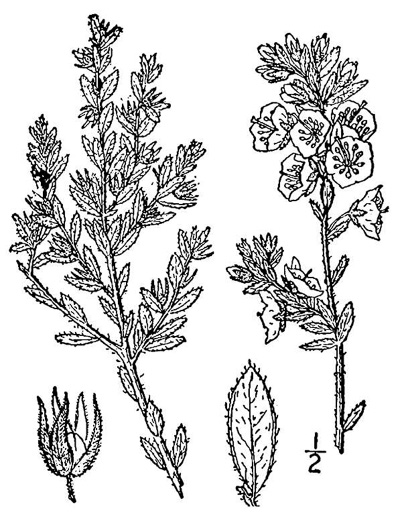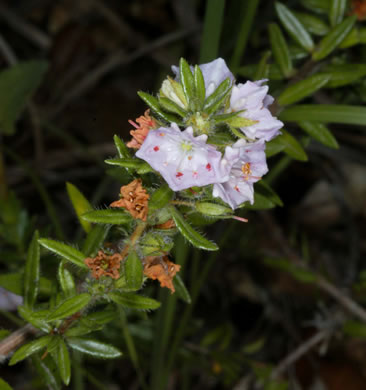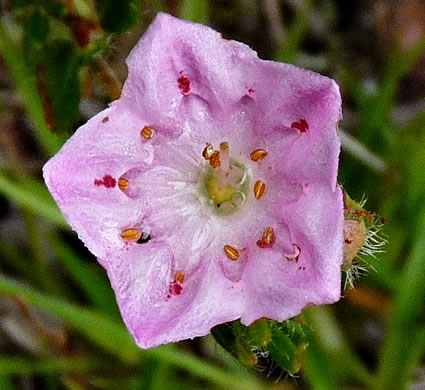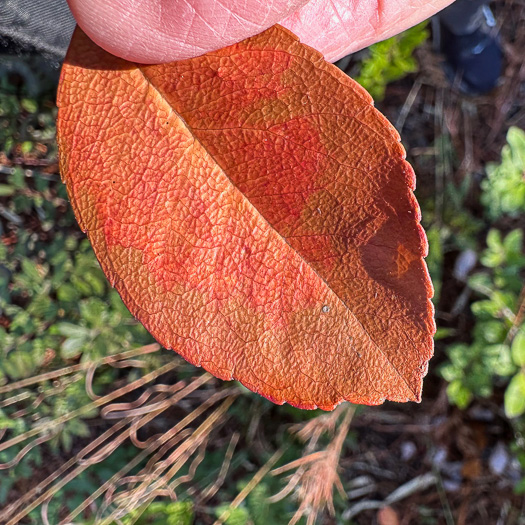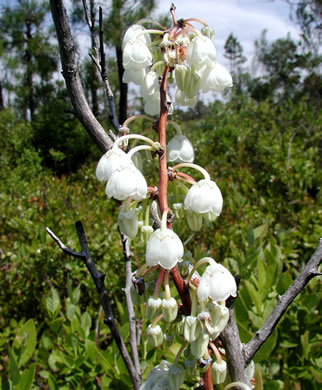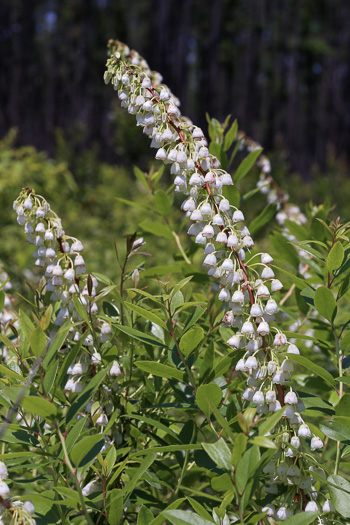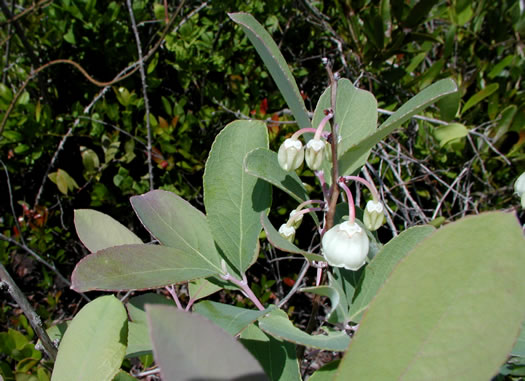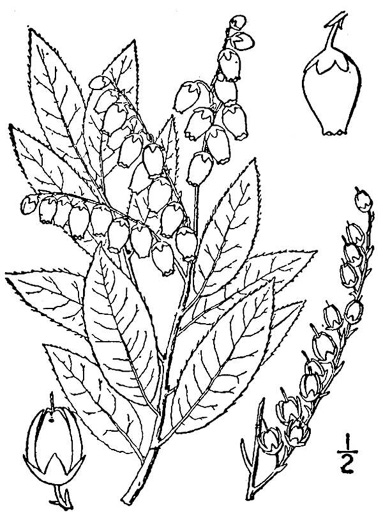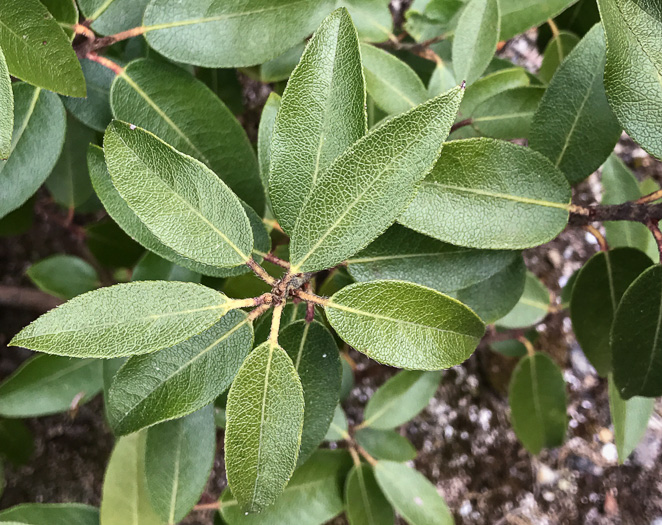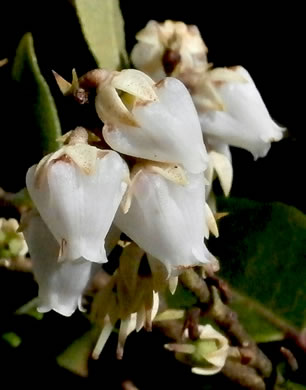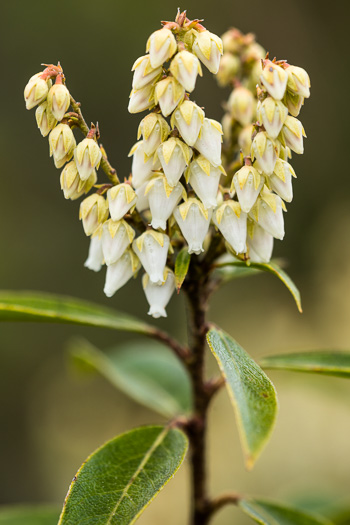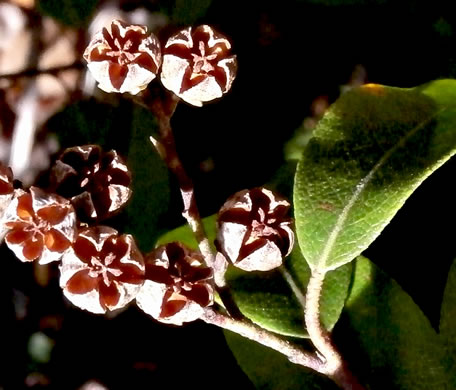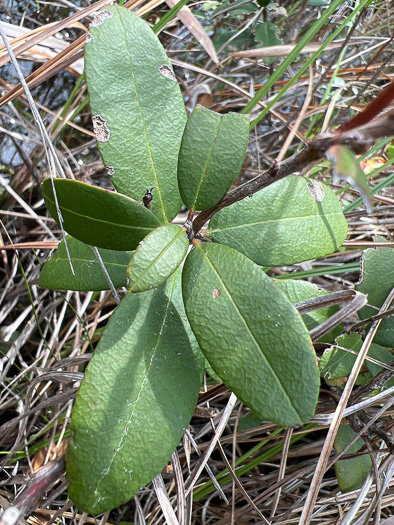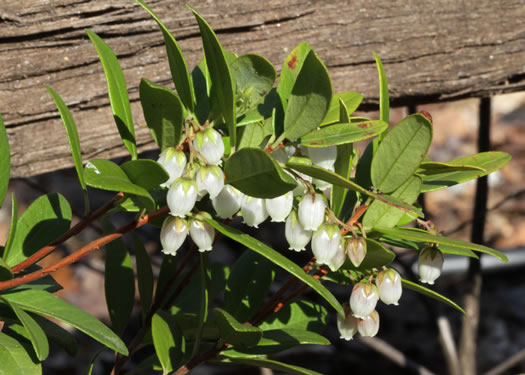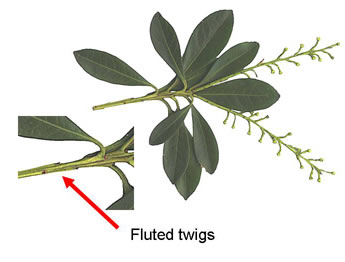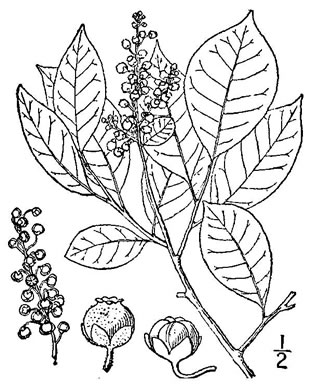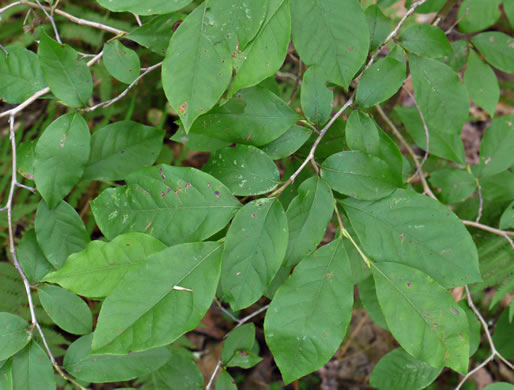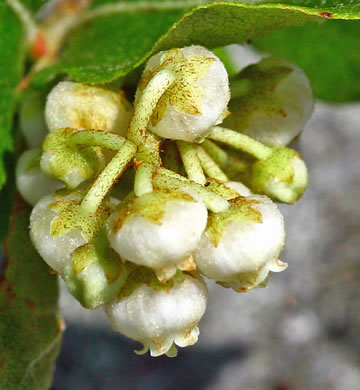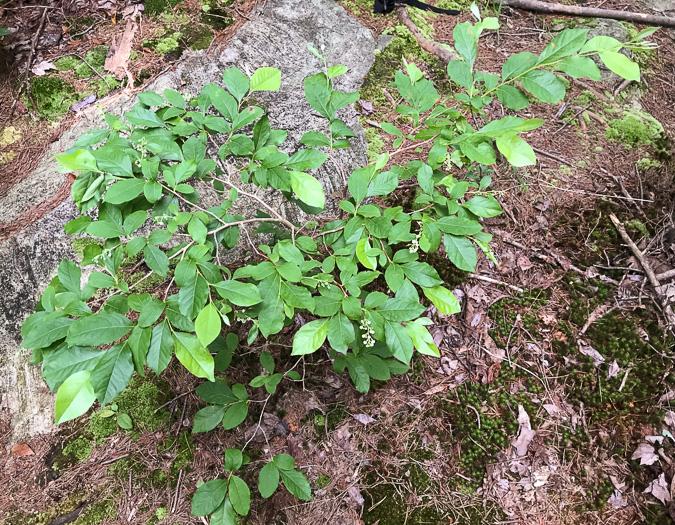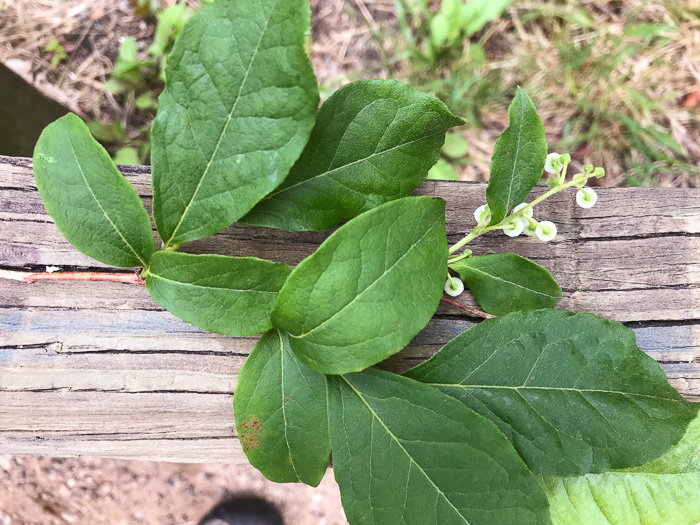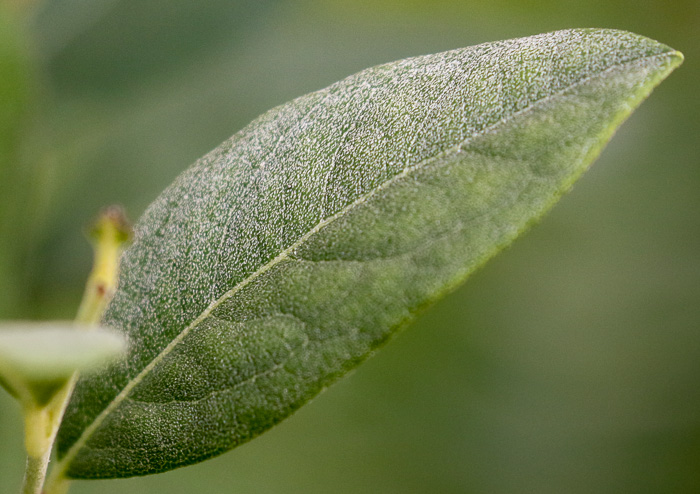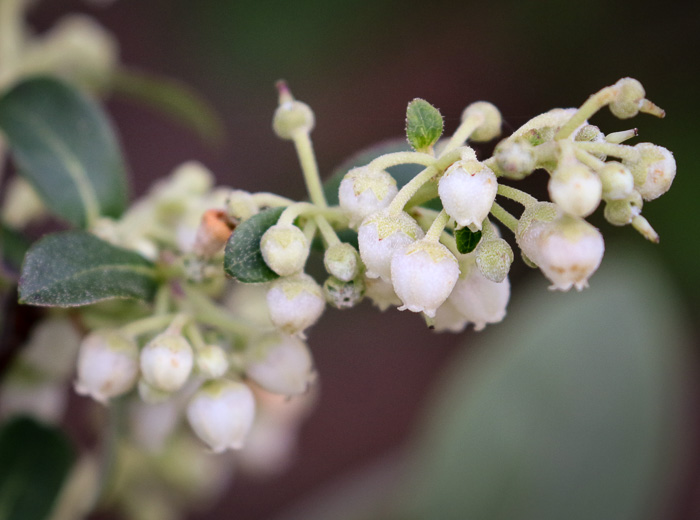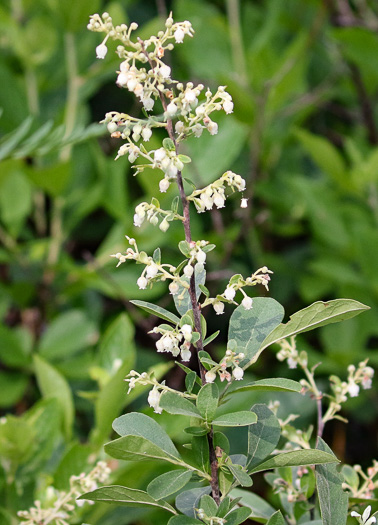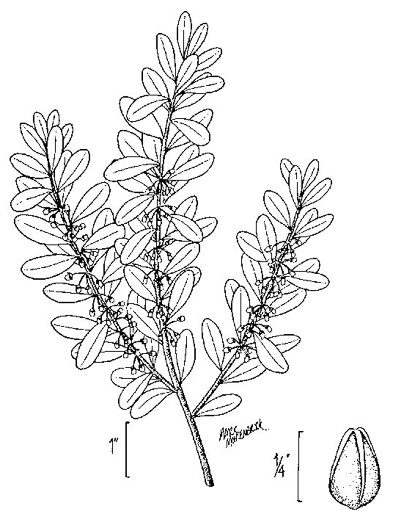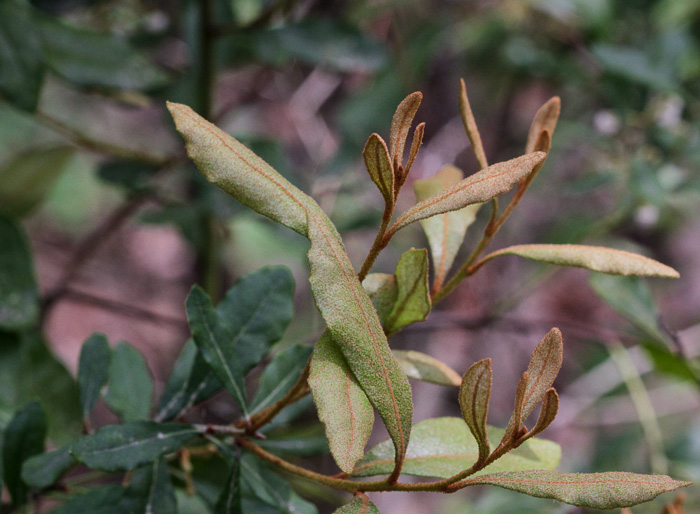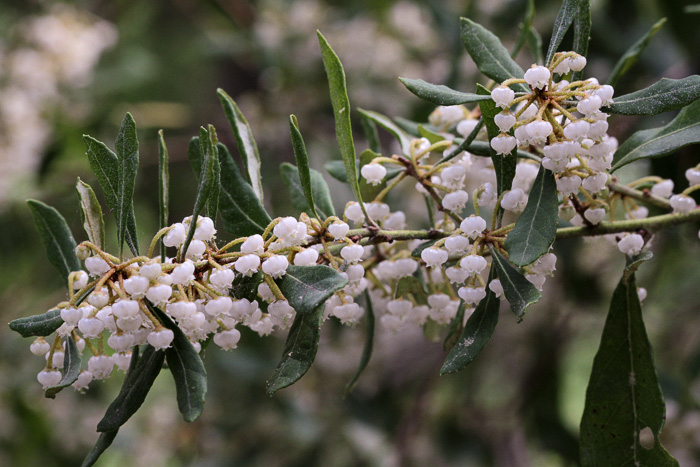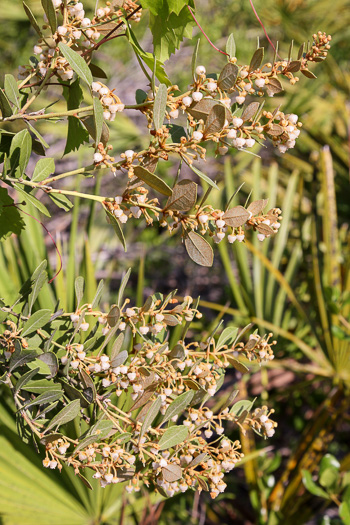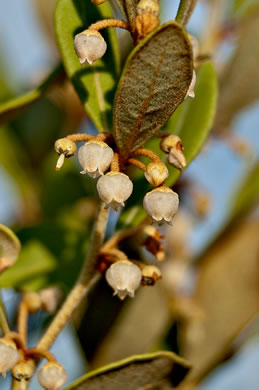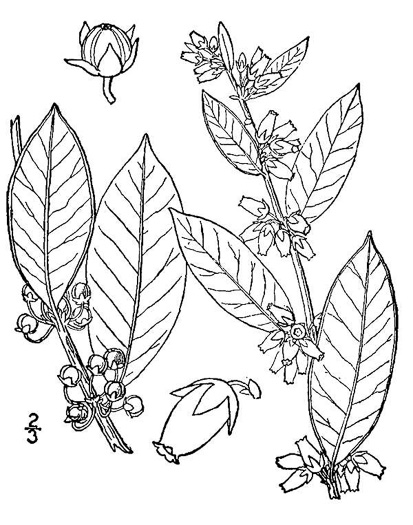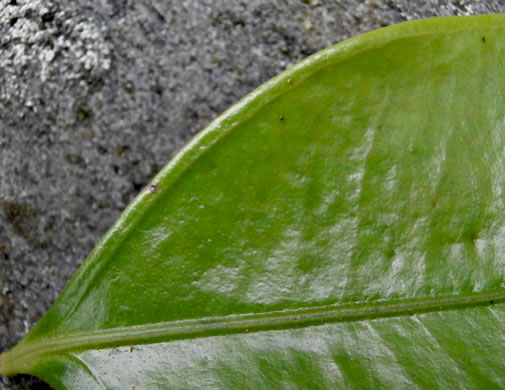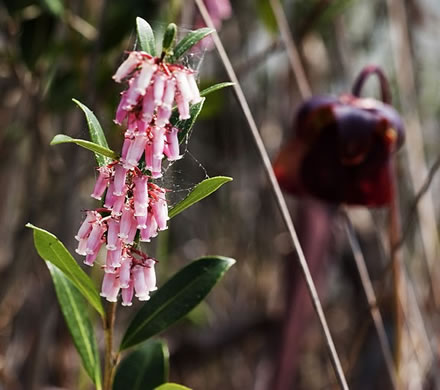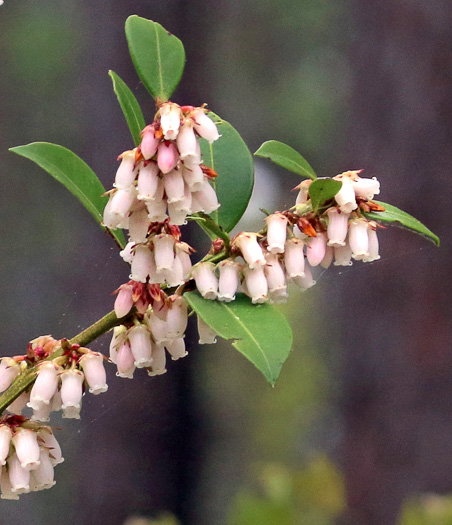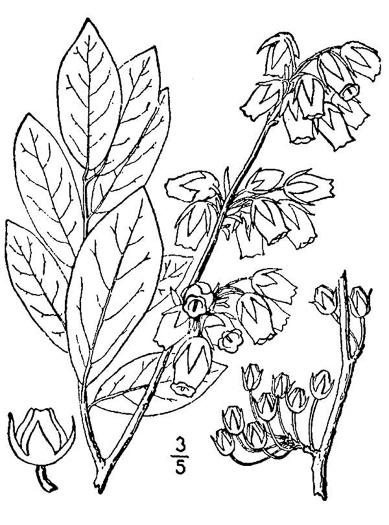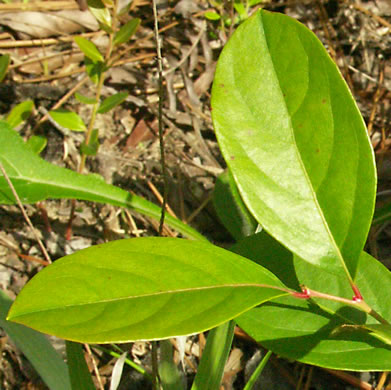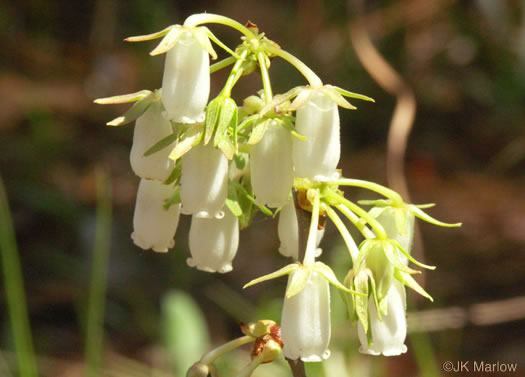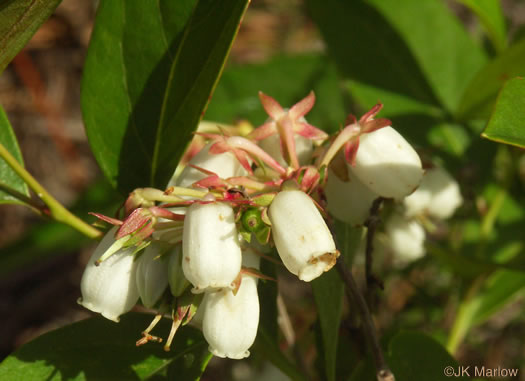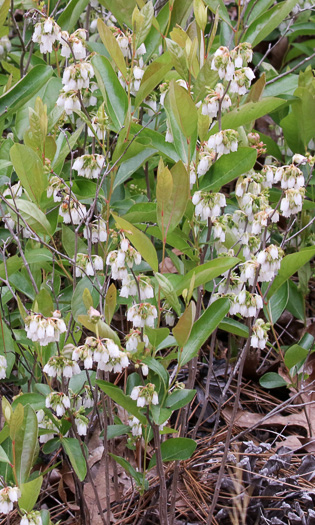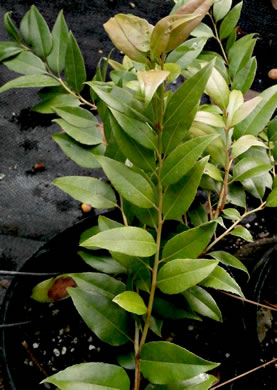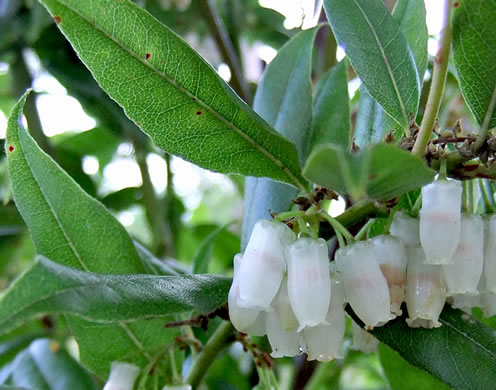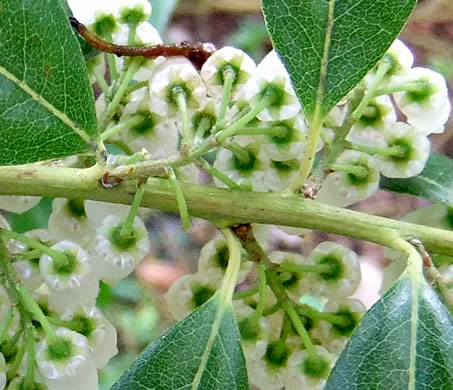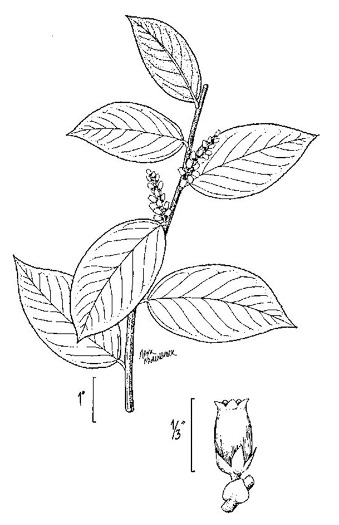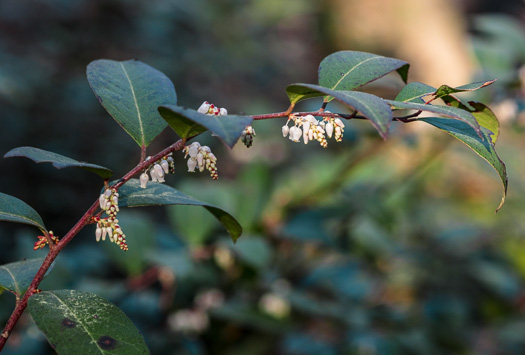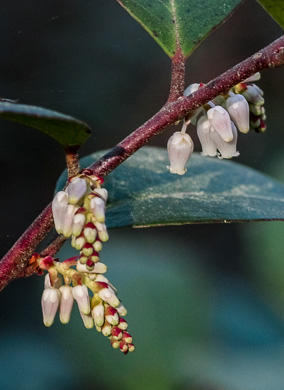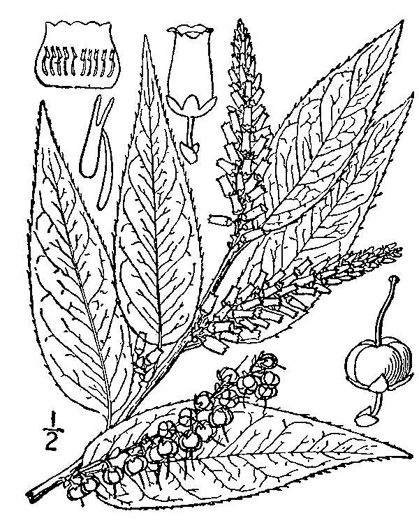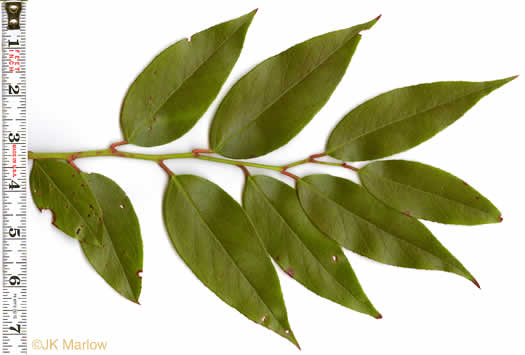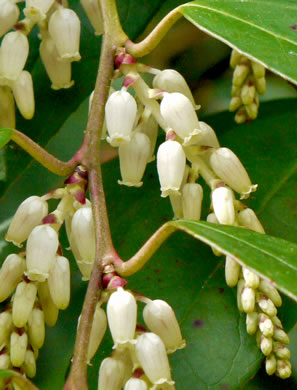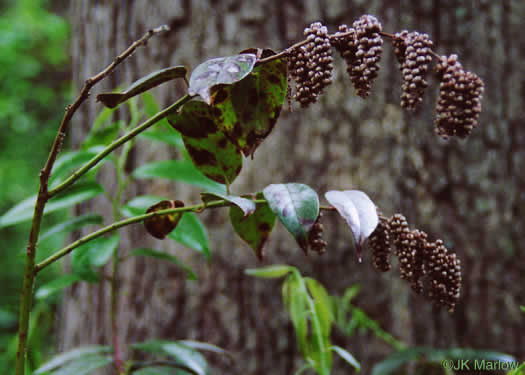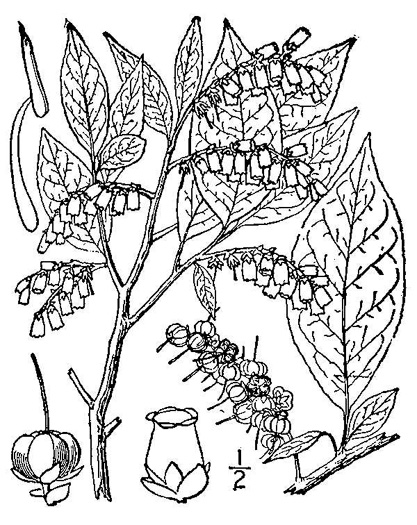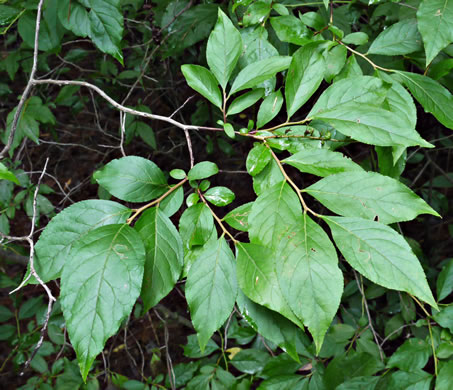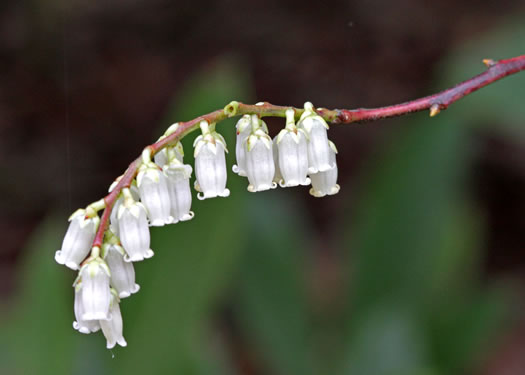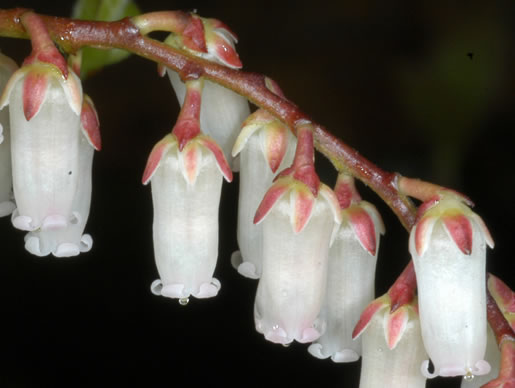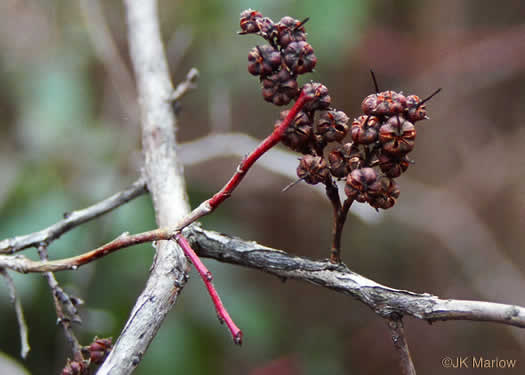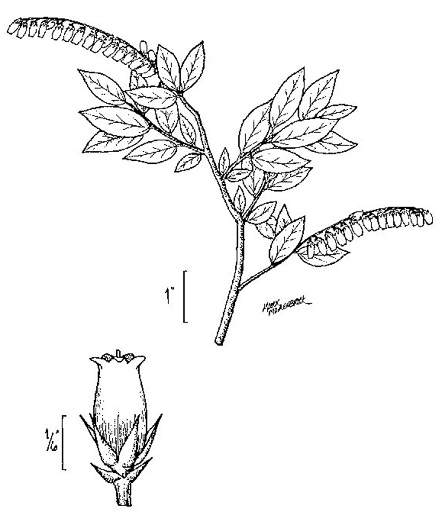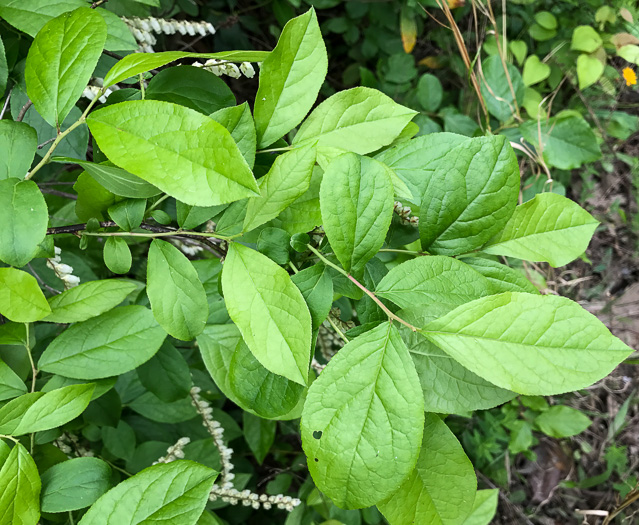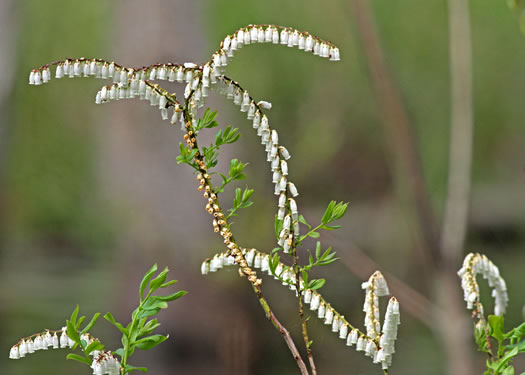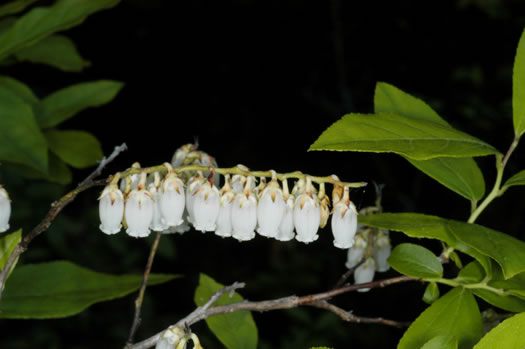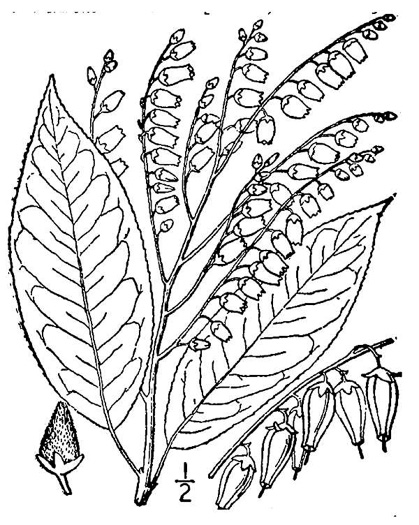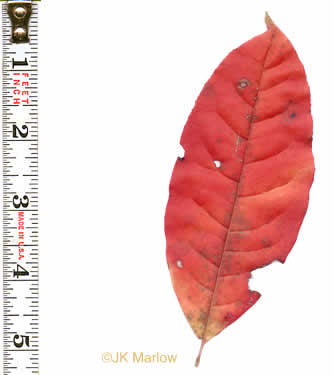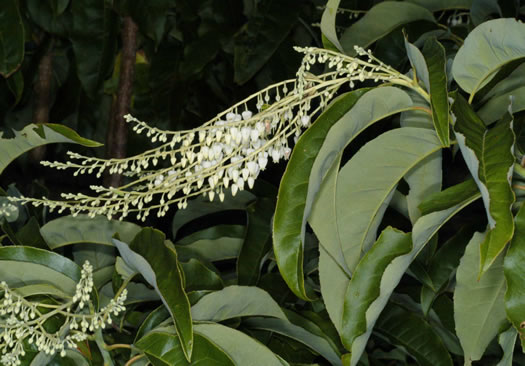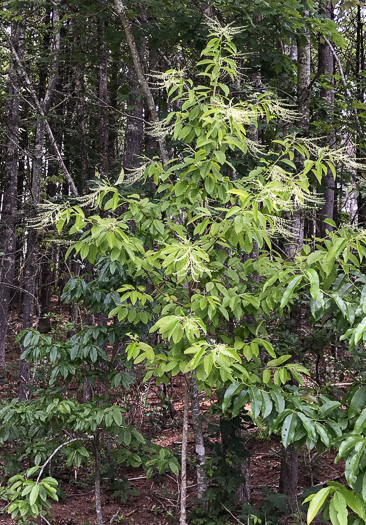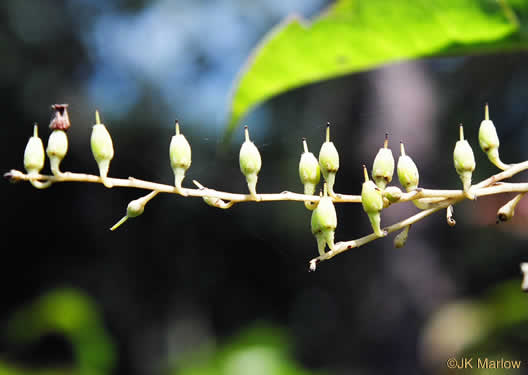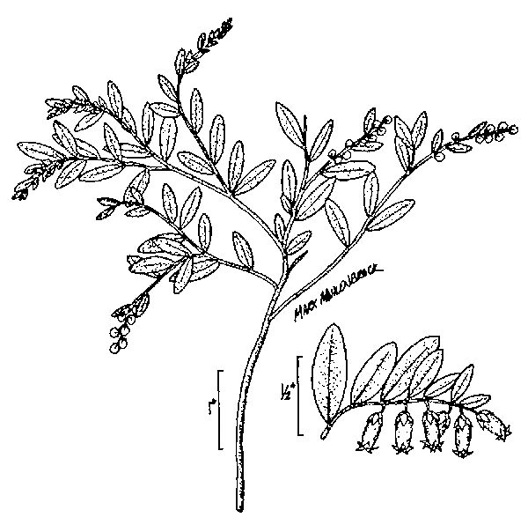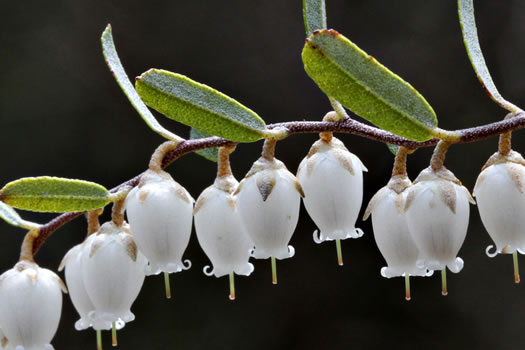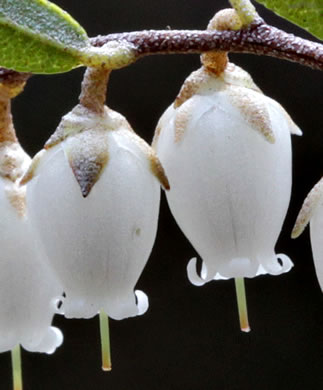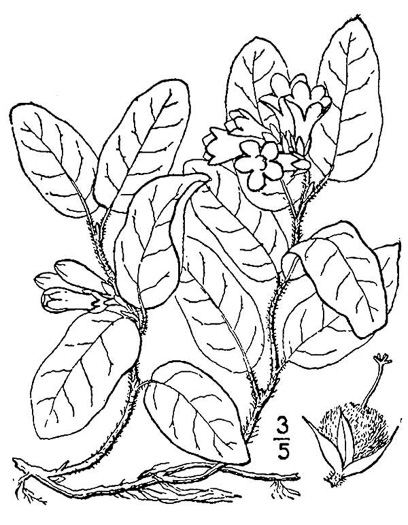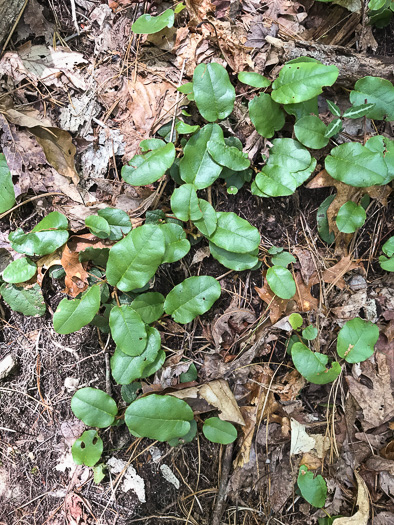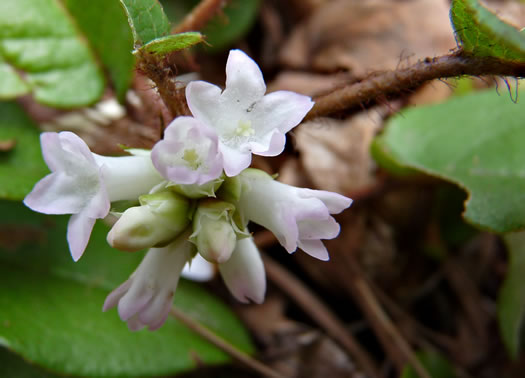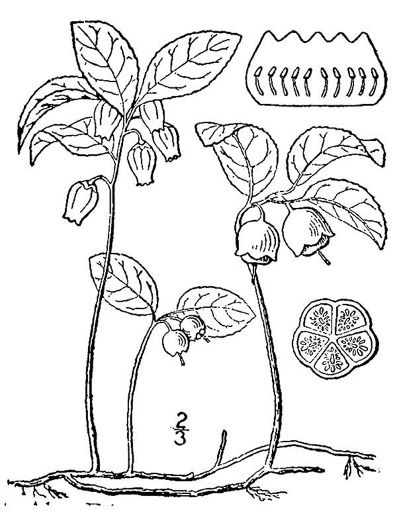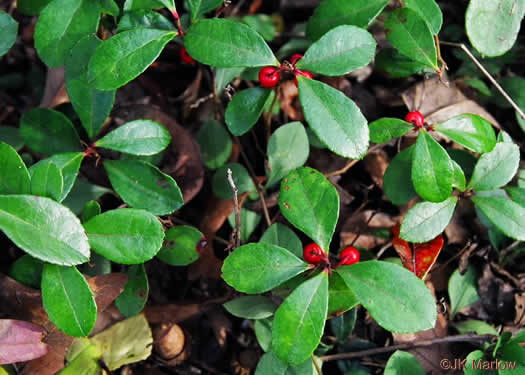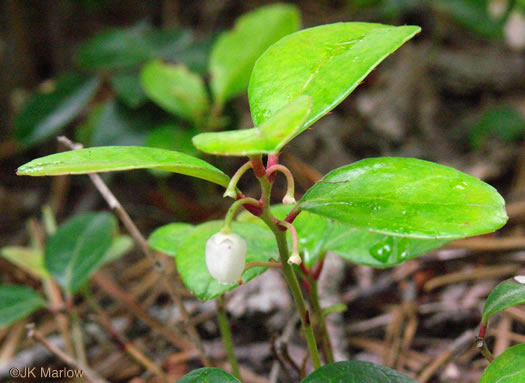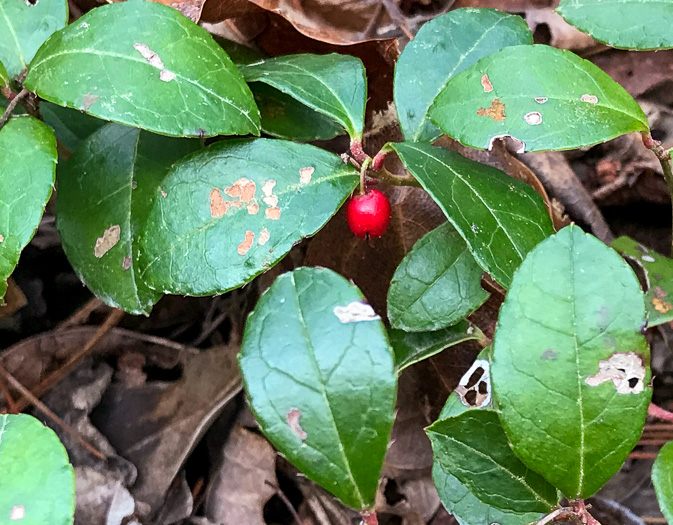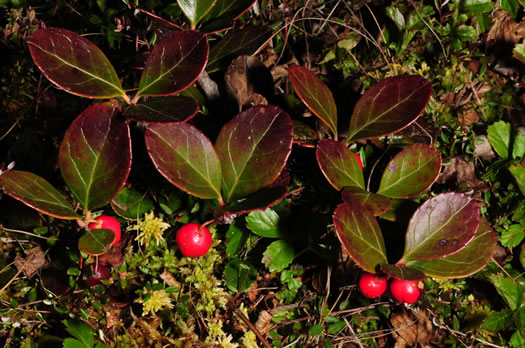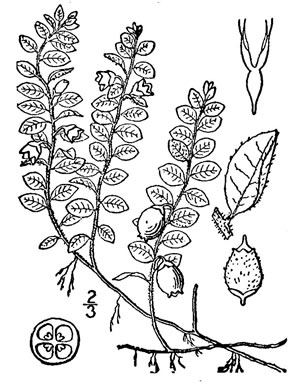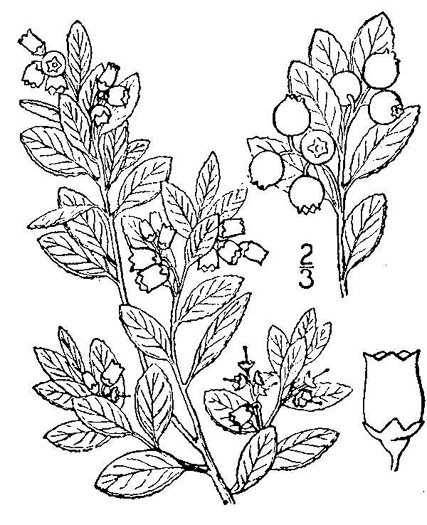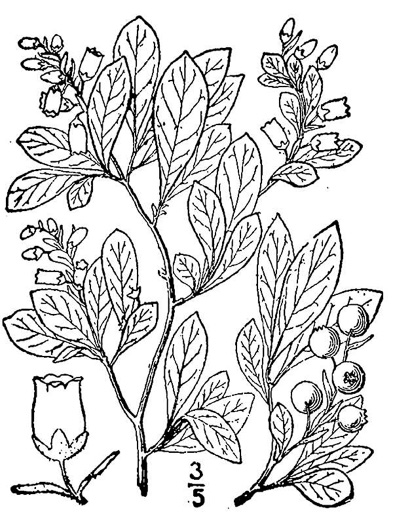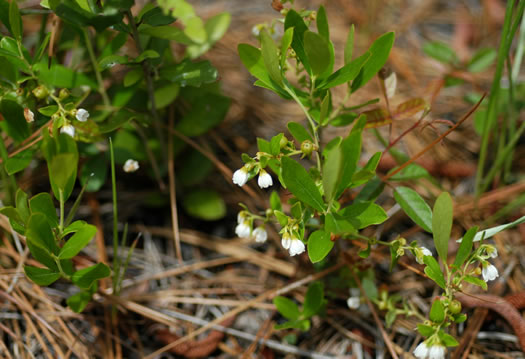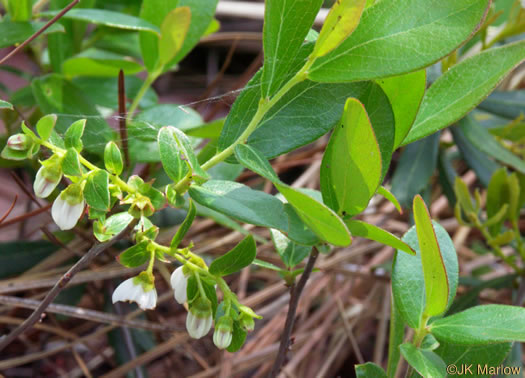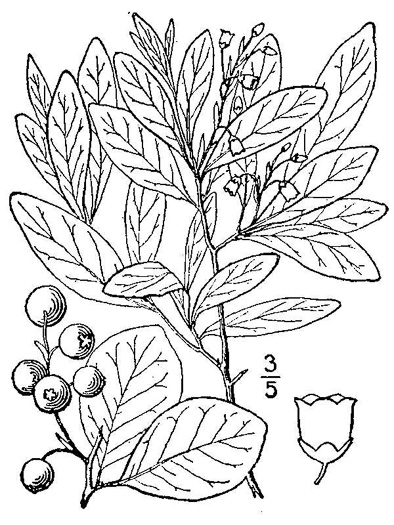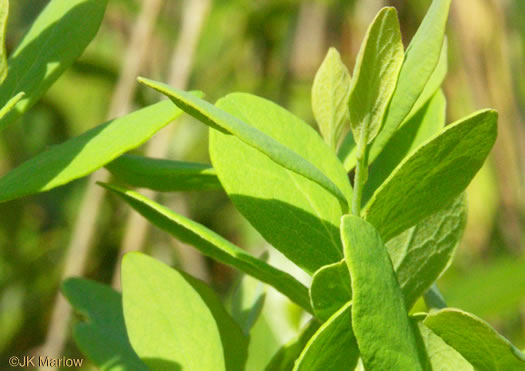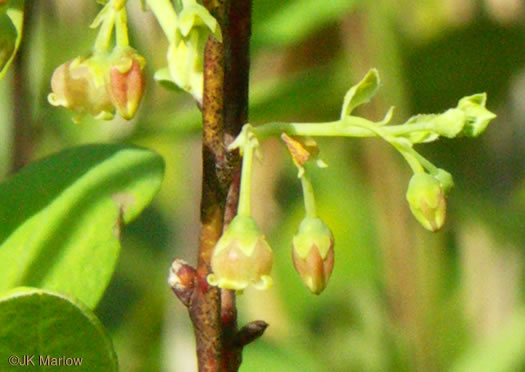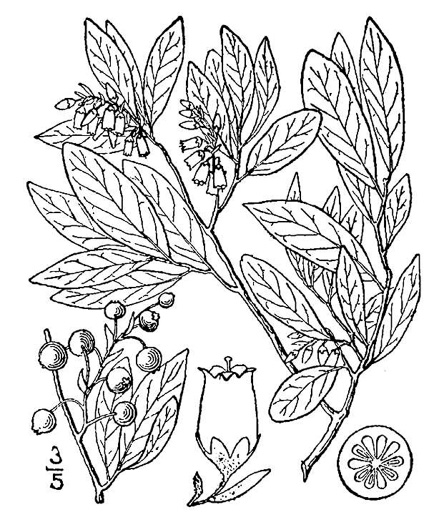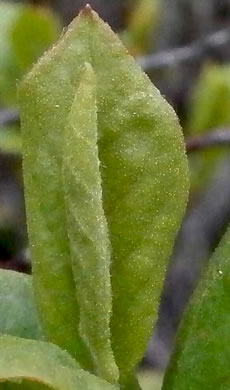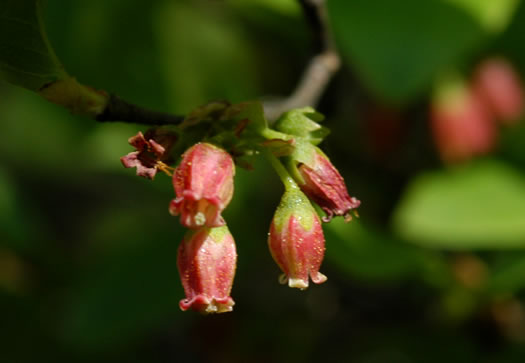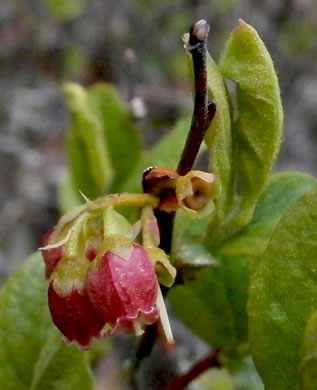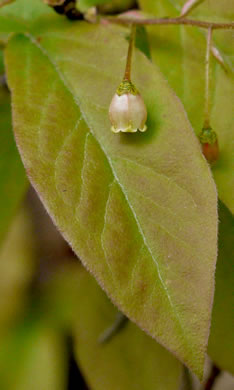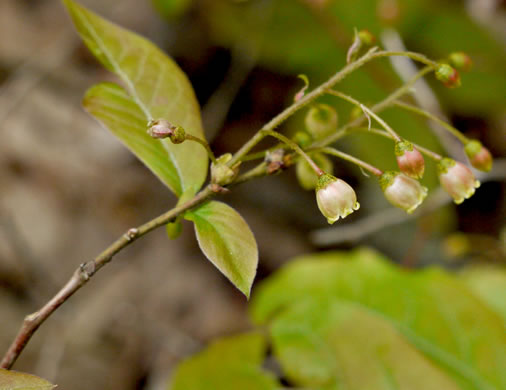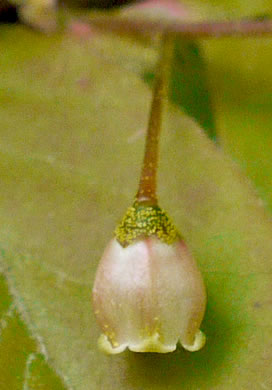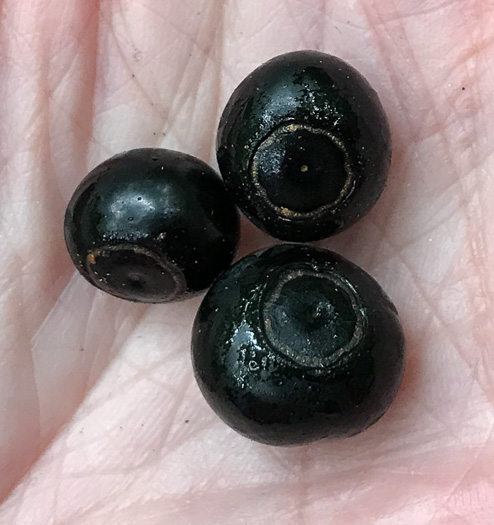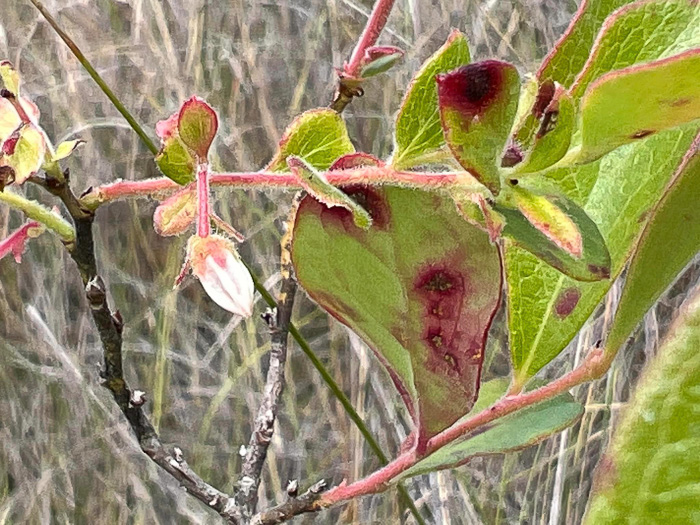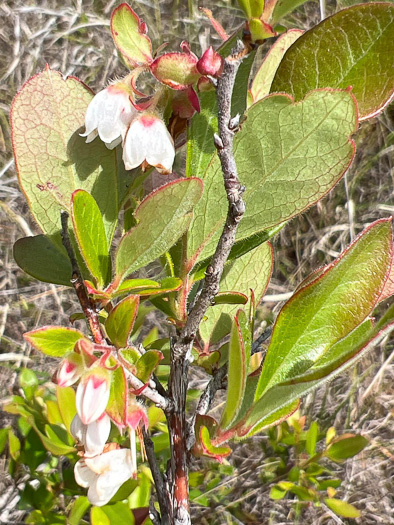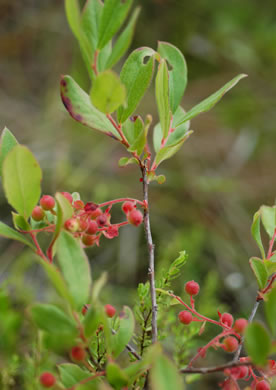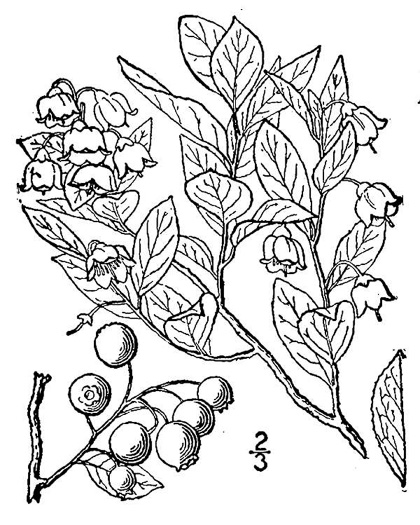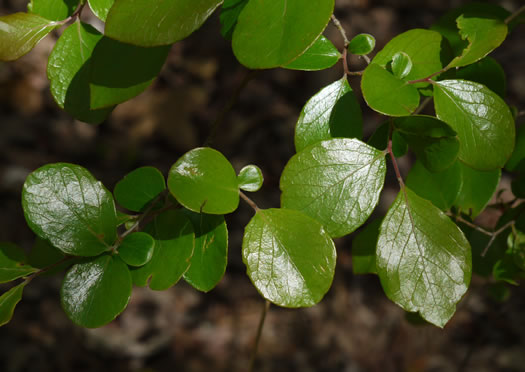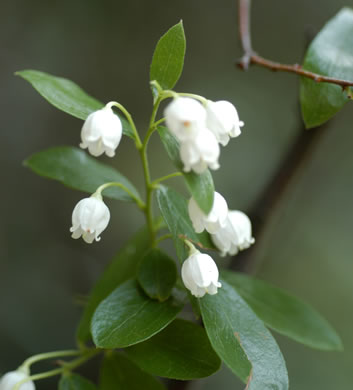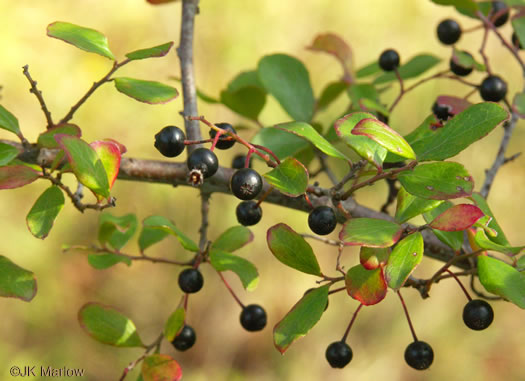Hovering over an image will enlarge it and point out features (works better on desktop than on mobile).
![]() A camera indicates there are pictures.
A camera indicates there are pictures.
![]() A speaker indicates that a botanical name is pronounced.
A speaker indicates that a botanical name is pronounced.
![]() A plus sign after a Latin name indicates that the species is further divided into varieties or subspecies.
A plus sign after a Latin name indicates that the species is further divided into varieties or subspecies.
Most habitat and range descriptions were obtained from Weakley's Flora.
Your search found 89 taxa in the family Ericaceae, Heath family, as understood by PLANTS National Database.

![]()
![]() Common Name:
Rosebay Rhododendron, Great Laurel, White Rosebay, Great Rhododendron
Common Name:
Rosebay Rhododendron, Great Laurel, White Rosebay, Great Rhododendron
Weakley's Flora: (4/24/22) Rhododendron maximum FAMILY: Ericaceae
SYNONYMOUS WITH PLANTS National Database: Rhododendron maximum FAMILY: Ericaceae
SYNONYMOUS WITH Vascular Flora of the Carolinas (Radford, Ahles, & Bell, 1968): Rhododendron maximum 145-05-001 FAMILY: Ericaceae
Habitat: Moist slopes, wet flats, bogs, swamps, north-facing bluffs in the Piedmont
Common in Mountains, uncommon in Piedmont
Native to the Carolinas & Georgia

![]()
![]() Common Name:
Catawba Rhododendron, Mountain Rosebay, Purple Laurel, Pink Laurel
Common Name:
Catawba Rhododendron, Mountain Rosebay, Purple Laurel, Pink Laurel
Weakley's Flora: (4/24/22) Rhododendron catawbiense FAMILY: Ericaceae
SYNONYMOUS WITH PLANTS National Database: Rhododendron catawbiense FAMILY: Ericaceae
SYNONYMOUS WITH Vascular Flora of the Carolinas (Radford, Ahles, & Bell, 1968): Rhododendron catawbiense 145-05-002 FAMILY: Ericaceae
Habitat: Rocky summits, shrub balds, acid ridges and slopes (mostly at high elevations), north-facing bluffs in the Piedmont, and sometimes in mesic situations in the Mountains
Common in Mountains of GA & NC (rare elsewhere in GA-NC-SC)
Native to the Carolinas & Georgia

![]()
![]() Common Name:
Gorge Rhododendron, Punctatum, Piedmont Rhododendron
Common Name:
Gorge Rhododendron, Punctatum, Piedmont Rhododendron
Weakley's Flora: (4/24/22) Rhododendron minus FAMILY: Ericaceae
SYNONYMOUS WITH PLANTS National Database: Rhododendron minus FAMILY: Ericaceae
INCLUDED WITHIN Vascular Flora of the Carolinas (Radford, Ahles, & Bell, 1968): Rhododendron minus 145-05-003 FAMILY: Ericaceae
Habitat: Rocky slopes, escarpment gorges, rocky areas in the Piedmont, longleaf pine sandhill bluffs in the Coastal Plain
Common in Mountains, uncommon in GA & SC Piedmont (rare elsewhere in GA-NC-SC)
Native to the Carolinas & Georgia

![]()
![]() Common Name:
Carolina Rhododendron, Punctatum
Common Name:
Carolina Rhododendron, Punctatum
Weakley's Flora: (4/24/22) Rhododendron carolinianum FAMILY: Ericaceae
SYNONYMOUS WITH PLANTS National Database: Rhododendron carolinianum FAMILY: Ericaceae
INCLUDED WITHIN Vascular Flora of the Carolinas (Radford, Ahles, & Bell, 1968): Rhododendron minus 145-05-003? FAMILY: Ericaceae
Habitat: Rocky summits, heath balds, high elevation forests, moist slopes
Uncommon in Carolina Mountains
Native to the Carolinas

![]()
![]() Common Name:
Pinkshell Azalea
Common Name:
Pinkshell Azalea
Weakley's Flora: (4/24/22) Rhododendron vaseyi FAMILY: Ericaceae
SYNONYMOUS WITH PLANTS National Database: Rhododendron vaseyi FAMILY: Ericaceae
SYNONYMOUS WITH Vascular Flora of the Carolinas (Radford, Ahles, & Bell, 1968): Rhododendron vaseyi 145-05-004 FAMILY: Ericaceae
Habitat: Moist slopes, bogs, high elevation rocky summits, cliffs, high elevation heath balds
Rare
Native to North Carolina & possibly Georgia

![]()
![]() Common Name:
Flame Azalea
Common Name:
Flame Azalea
Weakley's Flora: (4/24/22) Rhododendron calendulaceum FAMILY: Ericaceae
SYNONYMOUS WITH PLANTS National Database: Rhododendron calendulaceum FAMILY: Ericaceae
SYNONYMOUS WITH Vascular Flora of the Carolinas (Radford, Ahles, & Bell, 1968): Rhododendron calendulaceum 145-05-005 FAMILY: Ericaceae
Habitat: Deciduous forests, particularly on mountain slopes, grassy balds
Common in Mountains, rare in Piedmont
Native to the Carolinas & Georgia

![]()
![]() Common Name:
Oconee Azalea
Common Name:
Oconee Azalea
Weakley's Flora: (4/14/23) Rhododendron flammeum FAMILY: Ericaceae
SYNONYMOUS WITH PLANTS National Database: Rhododendron flammeum FAMILY: Ericaceae
Habitat: Longleaf pine sandhills, upland forests on slopes, ridges, stream bluffs
Uncommon in GA Piedmont & GA Coastal Plain (rare elsewhere in GA-NC-SC)
Native to South Carolina & Georgia

![]()
![]() Common Name:
Plumleaf Azalea
Common Name:
Plumleaf Azalea
Weakley's Flora: (4/14/23) Rhododendron prunifolium FAMILY: Ericaceae
SYNONYMOUS WITH PLANTS National Database: Rhododendron prunifolium FAMILY: Ericaceae
Habitat: Mesic ravine forests and streambanks
Rare, endemic to a small area along AL-GA border
Native to Georgia

![]()
![]() Common Name:
Cumberland Azalea, Baker's Azalea
Common Name:
Cumberland Azalea, Baker's Azalea
Weakley's Flora: (4/14/23) Rhododendron cumberlandense FAMILY: Ericaceae
SYNONYMOUS WITH PLANTS National Database: Rhododendron cumberlandense FAMILY: Ericaceae
Habitat: Balds and exposed or moist slopes
Rare
Native to North Carolina & Georgia

![]()
![]() Common Name:
Piedmont Azalea, Southern Pinxter Azalea, Hoary Azalea
Common Name:
Piedmont Azalea, Southern Pinxter Azalea, Hoary Azalea
Weakley's Flora: (4/24/22) Rhododendron canescens FAMILY: Ericaceae
SYNONYMOUS WITH PLANTS National Database: Rhododendron canescens FAMILY: Ericaceae
SYNONYMOUS WITH Vascular Flora of the Carolinas (Radford, Ahles, & Bell, 1968): Rhododendron canescens 145-05-006 FAMILY: Ericaceae
Habitat: Swamps, pocosins, and pine savannas
Common (uncommon in SC Mountains & NC Coastal Plain) (rare in NC Mountains & NC Piedmont)
Native to the Carolinas & Georgia

![]()
![]() Common Name:
Florida Flame Azalea, Yellow Azalea
Common Name:
Florida Flame Azalea, Yellow Azalea
Weakley's Flora: (4/14/23) Rhododendron austrinum FAMILY: Ericaceae
SYNONYMOUS WITH PLANTS National Database: Rhododendron austrinum FAMILY: Ericaceae
Habitat: Hammocks, bluffs, floodplain forests
Rare
Native to Georgia

![]()
![]() Common Name:
Election Pink, Roseshell Azalea, Early Azalea
Common Name:
Election Pink, Roseshell Azalea, Early Azalea
Weakley's Flora: (4/24/22) Rhododendron prinophyllum FAMILY: Ericaceae
SYNONYMOUS WITH PLANTS National Database: Rhododendron prinophyllum FAMILY: Ericaceae
SYNONYMOUS WITH Vascular Flora of the Carolinas (Radford, Ahles, & Bell, 1968): Rhododendron roseum 145-05-007 FAMILY: Ericaceae
Habitat: Upland forests (especially under Quercus montana and Quercus rubra), xeric pine and oak woodlands
Rare
Native to North Carolina & Georgia

![]()
![]() Common Name:
May White Azalea, Eastman's Azalea
Common Name:
May White Azalea, Eastman's Azalea
Weakley's Flora: (4/24/22) Rhododendron eastmanii FAMILY: Ericaceae
SYNONYMOUS WITH PLANTS National Database: Rhododendron eastmanii FAMILY: Ericaceae
INCLUDED WITHIN (MISAPPLIED) Vascular Flora of the Carolinas (Radford, Ahles, & Bell, 1968): Rhododendron alabamense 145-05-008 FAMILY: Ericaceae
Habitat: Rich slopes
Uncommon in SC Piedmont, rare in SC Coastal Plain
Native to South Carolina

![]()
![]() Common Name:
Red Hills Azalea, May-pink Azalea
Common Name:
Red Hills Azalea, May-pink Azalea
Weakley's Flora: (4/14/23) Rhododendron colemanii FAMILY: Ericaceae
Habitat: Moist hammocks, moist bluffs, along streams
Rare
Native to Georgia

![]() Common Name:
Alabama Azalea
Common Name:
Alabama Azalea
Weakley's Flora: (4/14/23) Rhododendron alabamense FAMILY: Ericaceae
SYNONYMOUS WITH PLANTS National Database: Rhododendron alabamense FAMILY: Ericaceae
Habitat: Moist slopes, bluffs, streambanks
Uncommon
Native to Georgia

![]()
![]() Common Name:
Pinxterflower, Pinxterbloom Azalea, Election Pink, Pinxter Azalea
Common Name:
Pinxterflower, Pinxterbloom Azalea, Election Pink, Pinxter Azalea
Weakley's Flora: (4/24/22) Rhododendron periclymenoides FAMILY: Ericaceae
SYNONYMOUS WITH PLANTS National Database: Rhododendron periclymenoides FAMILY: Ericaceae
SYNONYMOUS WITH Vascular Flora of the Carolinas (Radford, Ahles, & Bell, 1968): Rhododendron nudiflorum 145-05-009 FAMILY: Ericaceae
Habitat: Moist to dry slopes and streambanks
Common (rare in GA Coastal Plain)
Native to the Carolinas & Georgia

![]()
![]() Common Name:
Dwarf Azalea, Coastal Azalea
Common Name:
Dwarf Azalea, Coastal Azalea
Weakley's Flora: (4/24/22) Rhododendron atlanticum FAMILY: Ericaceae
SYNONYMOUS WITH PLANTS National Database: Rhododendron atlanticum FAMILY: Ericaceae
SYNONYMOUS WITH Vascular Flora of the Carolinas (Radford, Ahles, & Bell, 1968): Rhododendron atlanticum 145-05-010 FAMILY: Ericaceae
Habitat: Pocosins, pine savannas, pine flatwoods, sandhill-pocosin ecotones
Common in Carolina Coastal Plain, uncommon in GA
Native to the Carolinas & Georgia

![]()
![]() Common Name:
Swamp Azalea, Clammy Azalea, Swamp Honeysuckle, Catchfly Azalea
Common Name:
Swamp Azalea, Clammy Azalea, Swamp Honeysuckle, Catchfly Azalea
Weakley's Flora: (4/14/23) Rhododendron viscosum var. viscosum FAMILY: Ericaceae
INCLUDED WITHIN PLANTS National Database: Rhododendron viscosum FAMILY: Ericaceae
INCLUDED WITHIN Vascular Flora of the Carolinas (Radford, Ahles, & Bell, 1968): Rhododendron viscosum var. viscosum 145-05-011a FAMILY: Ericaceae
Habitat: Moist streambanks, shrub balds, and other moist habitats
Common in Piedmont & in Carolina Mountains (rare elsewhere in GA-NC-SC)
Native to the Carolinas & Georgia

Common Name: Clammy Azalea
Weakley's Flora: (4/14/23) Rhododendron viscosum var. montanum FAMILY: Ericaceae
INCLUDED WITHIN PLANTS National Database: Rhododendron viscosum FAMILY: Ericaceae
INCLUDED WITHIN Vascular Flora of the Carolinas (Radford, Ahles, & Bell, 1968): Rhododendron viscosum var. viscosum 145-05-011a? FAMILY: Ericaceae
Habitat: Moderate to high elevation sites, in dry to seasonally seepy sites
Uncommon in NC Mountains, rare in Mountains of GA & SC
Native to the Carolinas & Georgia

![]() Common Name:
Swamp Azalea, Clammy Azalea, Sweet Azalea
Common Name:
Swamp Azalea, Clammy Azalea, Sweet Azalea
Weakley's Flora: (4/14/23) Rhododendron serrulatum FAMILY: Ericaceae
INCLUDED WITHIN PLANTS National Database: Rhododendron viscosum FAMILY: Ericaceae
SYNONYMOUS WITH Vascular Flora of the Carolinas (Radford, Ahles, & Bell, 1968): Rhododendron viscosum var. serrulatum 145-05-011b FAMILY: Ericaceae
Habitat: Bogs, pocosins, wet pine savannas
Common in Coastal Plain
Native to the Carolinas & Georgia

![]()
![]() Common Name:
Sweet Azalea, Smooth Azalea
Common Name:
Sweet Azalea, Smooth Azalea
Weakley's Flora: (4/24/22) Rhododendron arborescens FAMILY: Ericaceae
SYNONYMOUS WITH PLANTS National Database: Rhododendron arborescens FAMILY: Ericaceae
SYNONYMOUS WITH Vascular Flora of the Carolinas (Radford, Ahles, & Bell, 1968): Rhododendron arborescens 145-05-012 FAMILY: Ericaceae
Habitat: Rocky riversides, wooded stream banks, swamps, high elevation forests, shrub balds
Common in Mountains, uncommon in Piedmont, rare in Coastal Plain
Native to the Carolinas & Georgia

![]()
![]() Common Name:
Minniebush
Common Name:
Minniebush
Weakley's Flora: (4/14/23) Rhododendron pilosum FAMILY: Ericaceae
SYNONYMOUS WITH PLANTS National Database: Menziesia pilosa FAMILY: Ericaceae
SYNONYMOUS WITH Vascular Flora of the Carolinas (Radford, Ahles, & Bell, 1968): Menziesia pilosa 145-06-001 FAMILY: Ericaceae
Habitat: Heath balds, bogs, rocky summits, and rocky woodlands, mostly at high elevations
Common in NC Mountains (rare elsewhere in GA-NC-SC)
Native to the Carolinas & Georgia

![]()
![]() Common Name:
Sand-myrtle, Mountain Myrtle
Common Name:
Sand-myrtle, Mountain Myrtle
Weakley's Flora: (4/24/22) Kalmia buxifolia FAMILY: Ericaceae
SYNONYMOUS WITH PLANTS National Database: Leiophyllum buxifolium FAMILY: Ericaceae
INCLUDING Vascular Flora of the Carolinas (Radford, Ahles, & Bell, 1968): Leiophyllum buxifolium var. buxifolium 145-07-001 FAMILY: Ericaceae
Habitat: Locally abundant but very restricted in wet (spodosol) pinelands of the outer Coastal Plain (in Brunswick and Carteret counties, NC), locally common in relatively dry sandhills in a few locations in the Sandhills, disjunct in the Piedmont on a few quartzite monadnocks, fairly common in the mountains on rock outcrops at high to moderate elevations (on a wide variety of rock types)
Uncommon in NC Mountains, rare elsewhere
Native to the Carolinas & Georgia

![]()
![]() Common Name:
Mountain Laurel, Ivy, Calico-bush, Mountain Ivy
Common Name:
Mountain Laurel, Ivy, Calico-bush, Mountain Ivy
Weakley's Flora: (4/24/22) Kalmia latifolia FAMILY: Ericaceae
SYNONYMOUS WITH PLANTS National Database: Kalmia latifolia FAMILY: Ericaceae
SYNONYMOUS WITH Vascular Flora of the Carolinas (Radford, Ahles, & Bell, 1968): Kalmia latifolia 145-08-001 FAMILY: Ericaceae
Habitat: Acidic forests, bluffs, bogs, along sandhill steams, and in a wide range of other habitats, nearly ubiquitous in the mountains, up to at least 1600m, more restricted in habitat in the lower Piedmont and Coastal Plain
Common (uncommon in SC Coastal Plain, rare in GA Coastal Plain)
Native to the Carolinas & Georgia

![]()
![]() Common Name:
Southern Sheepkill, Carolina Wicky, Carolina Sheep Laurel, Carolina Bog Myrtle
Common Name:
Southern Sheepkill, Carolina Wicky, Carolina Sheep Laurel, Carolina Bog Myrtle
Weakley's Flora: (4/24/22) Kalmia carolina FAMILY: Ericaceae
SYNONYMOUS WITH PLANTS National Database: Kalmia carolina FAMILY: Ericaceae
SYNONYMOUS WITH (ORTHOGRAPHIC ERROR) Vascular Flora of the Carolinas (Radford, Ahles, & Bell, 1968): Kalmia angustifolia var. caroliniana 145-08-002 FAMILY: Ericaceae
Habitat: Moist to wet pinelands of the Coastal Plain, pocosin margins (or seemingly in pocosins or swamps because of fire suppression), mountain bogs and fens (and less commonly in rocky areas at high elevations) in the Mountains
Common in NC Coastal Plain, uncommon in SC Coastal Plain (rare in Mountains) (rare in GA)
Native to the Carolinas & Georgia

![]()
![]() Common Name:
Northern Sheepkill, Sheep Laurel, Lamb-kill
Common Name:
Northern Sheepkill, Sheep Laurel, Lamb-kill
Weakley's Flora: (4/24/22) Kalmia angustifolia FAMILY: Ericaceae
SYNONYMOUS WITH PLANTS National Database: Kalmia angustifolia FAMILY: Ericaceae
Habitat: Sandy, xeric to mesic hillsides and moist areas, rocky areas, in ne. NC and se. VA in longleaf pine sandhills
Rare
Native to North Carolina

![]()
![]() Common Name:
White Wicky
Common Name:
White Wicky
Weakley's Flora: (4/24/22) Kalmia cuneata FAMILY: Ericaceae
SYNONYMOUS WITH PLANTS National Database: Kalmia cuneata FAMILY: Ericaceae
SYNONYMOUS WITH Vascular Flora of the Carolinas (Radford, Ahles, & Bell, 1968): Kalmia cuneata 145-08-003 FAMILY: Ericaceae
Habitat: Pocosins and pocosin-savanna or pocosin-sandhill ecotones
Rare
Native to the Carolinas

![]() Common Name:
Hairy Wicky, Kalmiella
Common Name:
Hairy Wicky, Kalmiella
Weakley's Flora: (4/24/22) Kalmia hirsuta FAMILY: Ericaceae
SYNONYMOUS WITH PLANTS National Database: Kalmia hirsuta FAMILY: Ericaceae
SYNONYMOUS WITH Vascular Flora of the Carolinas (Radford, Ahles, & Bell, 1968): Kalmia hirsuta 145-08-004 FAMILY: Ericaceae
Habitat: Pine savannas and pine flatwoods
Common in GA, rare in SC
Native to South Carolina & Georgia

![]() Common Name:
Zenobia, Honeycups
Common Name:
Zenobia, Honeycups
Weakley's Flora: (4/24/22) Zenobia pulverulenta FAMILY: Ericaceae
SYNONYMOUS WITH PLANTS National Database: Zenobia pulverulenta FAMILY: Ericaceae
SYNONYMOUS WITH Vascular Flora of the Carolinas (Radford, Ahles, & Bell, 1968): Zenobia pulverulenta 145-09-001 FAMILY: Ericaceae
Habitat: Pocosins, margins of pineland ponds
Common in Carolina Coastal Plain (rare in GA)
Native to the Carolinas & Georgia

![]()
![]() Common Name:
Evergreen Mountain Fetterbush, Mountain Andromeda
Common Name:
Evergreen Mountain Fetterbush, Mountain Andromeda
Weakley's Flora: (4/24/22) Pieris floribunda FAMILY: Ericaceae
SYNONYMOUS WITH PLANTS National Database: Pieris floribunda FAMILY: Ericaceae
SYNONYMOUS WITH Vascular Flora of the Carolinas (Radford, Ahles, & Bell, 1968): Pieris floribunda 145-10-001 FAMILY: Ericaceae
Habitat: Acid wooded slopes, heath balds at high elevations, summits of Piedmont monadnocks, sometimes escaped from cultivation
Uncommon in NC Mountains, rare in NC Piedmont
Native to North Carolina & possibly Georgia

![]() Common Name:
Vine-wicky, Climbing Fetterbush, Climbing Wicky
Common Name:
Vine-wicky, Climbing Fetterbush, Climbing Wicky
Weakley's Flora: (4/24/22) Pieris phillyreifolia FAMILY: Ericaceae
SYNONYMOUS WITH PLANTS National Database: Pieris phillyreifolia FAMILY: Ericaceae
Habitat: Acidic swamp forests
Uncommon in GA Coastal Plain, rare in SC
Native to South Carolina & Georgia

![]() Common Name:
Japanese Andromeda, Lily-of-the-Valley Bush
Common Name:
Japanese Andromeda, Lily-of-the-Valley Bush
Weakley's Flora: (4/24/22) Pieris japonica FAMILY: Ericaceae
SYNONYMOUS WITH PLANTS National Database: Pieris japonica FAMILY: Ericaceae
Habitat: Planted in landscaping, rarely escaping or persisting in our area
Non-native: Japan, Taiwan, & China

![]()
![]() Common Name:
Northern Maleberry, He-huckleberry
Common Name:
Northern Maleberry, He-huckleberry
Weakley's Flora: (4/24/22) Lyonia ligustrina var. ligustrina FAMILY: Ericaceae
SYNONYMOUS WITH PLANTS National Database: Lyonia ligustrina var. ligustrina FAMILY: Ericaceae
INCLUDED WITHIN Vascular Flora of the Carolinas (Radford, Ahles, & Bell, 1968): Lyonia ligustrina 145-11-001 FAMILY: Ericaceae
Habitat: Mountain bogs, shrub balds, bottomlands, other moist to wet habitats, "dry" exposed ridges at high elevations
Common (uncommon in GA Piedmont, uncommon in SC Coastal Plain)
Native to the Carolinas & Georgia

![]() Common Name:
Southern Maleberry, He-huckleberry
Common Name:
Southern Maleberry, He-huckleberry
Weakley's Flora: (4/24/22) Lyonia ligustrina var. foliosiflora FAMILY: Ericaceae
SYNONYMOUS WITH PLANTS National Database: Lyonia ligustrina var. foliosiflora FAMILY: Ericaceae
INCLUDED WITHIN Vascular Flora of the Carolinas (Radford, Ahles, & Bell, 1968): Lyonia ligustrina 145-11-001? FAMILY: Ericaceae
Habitat: Pocosins, seepage bogs, and other wet habitats
Common in Coastal Plain (rare elsewhere)
Native to the Carolinas & Georgia

![]()
![]() Common Name:
Rusty Lyonia, Staggerbush, Dragonwood, Crookedwood
Common Name:
Rusty Lyonia, Staggerbush, Dragonwood, Crookedwood
Weakley's Flora: (4/24/22) Lyonia ferruginea FAMILY: Ericaceae
SYNONYMOUS WITH PLANTS National Database: Lyonia ferruginea FAMILY: Ericaceae
INCLUDED WITHIN Vascular Flora of the Carolinas (Radford, Ahles, & Bell, 1968): Lyonia ferruginea 145-11-002 FAMILY: Ericaceae
Habitat: Dry oak and pine woodlands, Florida scrub, scrubby pine flatwoods, rarely pocosins, spodosolic flatwoods
Common in GA Coastal Plain, uncommon in SC
Native to South Carolina & Georgia

![]() Common Name:
Staggerbush, Poor-grub
Common Name:
Staggerbush, Poor-grub
Weakley's Flora: (4/24/22) Lyonia fruticosa FAMILY: Ericaceae
SYNONYMOUS WITH PLANTS National Database: Lyonia fruticosa FAMILY: Ericaceae
INCLUDED WITHIN Vascular Flora of the Carolinas (Radford, Ahles, & Bell, 1968): Lyonia ferruginea 145-11-002? FAMILY: Ericaceae
Habitat: Pocosins, Florida scrub, pine flatwoods
Common in GA Coastal Plain (historically in SC, but not recently seen)
Native to South Carolina & Georgia

![]()
![]() Common Name:
Shining Fetterbush, Lyonia, Hemleaf
Common Name:
Shining Fetterbush, Lyonia, Hemleaf
Weakley's Flora: (4/24/22) Lyonia lucida FAMILY: Ericaceae
SYNONYMOUS WITH PLANTS National Database: Lyonia lucida FAMILY: Ericaceae
SYNONYMOUS WITH Vascular Flora of the Carolinas (Radford, Ahles, & Bell, 1968): Lyonia lucida 145-11-003 FAMILY: Ericaceae
Habitat: Pocosins, wet woodlands, blackwater swamp forests, other acidic wetlands, especially if peaty. In peninsular FL this species occurs across a remarkable span of soil moistures, from deeply saturated acidic peats upslope into scrubby flatwoods
Common in Coastal Plain (rare in Piedmont)
Native to the Carolinas & Georgia

![]()
![]() Common Name:
Staggerbush, Large-flowered Fetterbush
Common Name:
Staggerbush, Large-flowered Fetterbush
Weakley's Flora: (4/24/22) Lyonia mariana FAMILY: Ericaceae
SYNONYMOUS WITH PLANTS National Database: Lyonia mariana FAMILY: Ericaceae
SYNONYMOUS WITH Vascular Flora of the Carolinas (Radford, Ahles, & Bell, 1968): Lyonia mariana 145-11-004 FAMILY: Ericaceae
Habitat: Pine flatwoods, savannas, pocosin-sandhill ecotones, less commonly in dry rocky woodlands in the lower Piedmont (especially with chestnut oak)
Common in Coastal Plain (uncommon in Piedmont)
Native to the Carolinas & Georgia

![]()
![]() Common Name:
Tall Fetterbush, Florida Leucothoe, Florida Hobblebush, Agarista
Common Name:
Tall Fetterbush, Florida Leucothoe, Florida Hobblebush, Agarista
Weakley's Flora: (4/24/22) Agarista populifolia FAMILY: Ericaceae
SYNONYMOUS WITH PLANTS National Database: Agarista populifolia FAMILY: Ericaceae
SYNONYMOUS WITH Vascular Flora of the Carolinas (Radford, Ahles, & Bell, 1968): Leucothoe populifolia 145-12-001 FAMILY: Ericaceae
Habitat: Blackwater swamps, hydric hammocks, marly spring runs and seepage ravines
Rare or waif(s)
Native to South Carolina & Georgia & possibly North Carolina

![]()
![]() Common Name:
Coastal Doghobble
Common Name:
Coastal Doghobble
Weakley's Flora: (4/24/22) Leucothoe axillaris FAMILY: Ericaceae
SYNONYMOUS WITH PLANTS National Database: Leucothoe axillaris FAMILY: Ericaceae
SYNONYMOUS WITH Vascular Flora of the Carolinas (Radford, Ahles, & Bell, 1968): Leucothoe axillaris var. axillaris 145-12-002a FAMILY: Ericaceae
Habitat: Pocosins, blackwater swamp forests, and moist and acid slopes
Common in Coastal Plain (rare in Piedmont)
Native to the Carolinas & Georgia

![]()
![]() Common Name:
Mountain Doghobble, Highland Doghobble, Switch-ivy
Common Name:
Mountain Doghobble, Highland Doghobble, Switch-ivy
Weakley's Flora: (4/24/22) Leucothoe fontanesiana FAMILY: Ericaceae
SYNONYMOUS WITH PLANTS National Database: Leucothoe fontanesiana FAMILY: Ericaceae
SYNONYMOUS WITH Vascular Flora of the Carolinas (Radford, Ahles, & Bell, 1968): Leucothoe axillaris var. editorum 145-12-002b FAMILY: Ericaceae
Habitat: Moist slopes, streambanks, ravines, often associated with Rhododendron maximum thickets
Common
Native to the Carolinas & Georgia

![]()
![]() Common Name:
Mountain Sweetbells, Mountain Fetterbush, Deciduous Fetterbush
Common Name:
Mountain Sweetbells, Mountain Fetterbush, Deciduous Fetterbush
Weakley's Flora: (4/24/22) Eubotrys recurvus FAMILY: Ericaceae
SYNONYMOUS WITH PLANTS National Database: Eubotrys recurvus FAMILY: Ericaceae
SYNONYMOUS WITH Vascular Flora of the Carolinas (Radford, Ahles, & Bell, 1968): Leucothoe recurva 145-12-003 FAMILY: Ericaceae
Habitat: Heath balds, high elevation ridges and granitic domes, bogs
Common in NC Mountains (rare elsewhere in GA-NC-SC)
Native to the Carolinas & Georgia

![]()
![]() Common Name:
Coastal Fetterbush, Swamp Sweetbells, Swamp Leucothoe, Swamp Fetterbush
Common Name:
Coastal Fetterbush, Swamp Sweetbells, Swamp Leucothoe, Swamp Fetterbush
Weakley's Flora: (4/24/22) Eubotrys racemosus FAMILY: Ericaceae
SYNONYMOUS WITH PLANTS National Database: Eubotrys racemosus FAMILY: Ericaceae
SYNONYMOUS WITH Vascular Flora of the Carolinas (Radford, Ahles, & Bell, 1968): Leucothoe racemosa 145-12-004 FAMILY: Ericaceae
Habitat: Swamps, pocosins, streambanks, and other wet places. Very rarely in scrubby flatwoods (c. FL)
Common in Coastal Plain, uncommon in Piedmont, rare in Mountains
Native to the Carolinas & Georgia

![]()
![]() Common Name:
Sourwood, Sorrel-tree
Common Name:
Sourwood, Sorrel-tree
Weakley's Flora: (4/24/22) Oxydendrum arboreum FAMILY: Ericaceae
SYNONYMOUS WITH PLANTS National Database: Oxydendrum arboreum FAMILY: Ericaceae
SYNONYMOUS WITH Vascular Flora of the Carolinas (Radford, Ahles, & Bell, 1968): Oxydendrum arboreum 145-13-001 FAMILY: Ericaceae
Habitat: Mesic to xeric deciduous forests, especially dry-mesic to xeric oak-hickory and oak-pine forests, and also often in sandhill/pocosin ecotones
Common
Native to the Carolinas & Georgia

![]()
![]() Common Name:
Leatherleaf, Cassandra
Common Name:
Leatherleaf, Cassandra
Weakley's Flora: (4/24/22) Chamaedaphne calyculata FAMILY: Ericaceae
SYNONYMOUS WITH PLANTS National Database: Chamaedaphne calyculata FAMILY: Ericaceae
SYNONYMOUS WITH Vascular Flora of the Carolinas (Radford, Ahles, & Bell, 1968): Cassandra calyculata 145-14-001 FAMILY: Ericaceae
Habitat: Pocosins in the Coastal Plain, bogs in the Mountains, Chamaecyparis bogs, wet pine flatwood ecotones, other saturated, acid, peaty or peaty/sandy situations
Common in NC Coastal Plain, uncommon in SC Coastal Plain (rare in NC Mountains)
Native to the Carolinas

![]()
![]() Common Name:
Trailing Arbutus, Mayflower
Common Name:
Trailing Arbutus, Mayflower
Weakley's Flora: (4/24/22) Epigaea repens FAMILY: Ericaceae
SYNONYMOUS WITH PLANTS National Database: Epigaea repens FAMILY: Ericaceae
SYNONYMOUS WITH Vascular Flora of the Carolinas (Radford, Ahles, & Bell, 1968): Epigaea repens 145-15-001 FAMILY: Ericaceae
Habitat: In a wide variety of acidic forests, xeric to mesic, sandy, rocky, and loamy, including longleaf pine sandhills
Common (uncommon GA Piedmont & SC Coastal Plain)
Native to the Carolinas & Georgia

![]()
![]() Common Name:
Wintergreen, Teaberry
Common Name:
Wintergreen, Teaberry
Weakley's Flora: (4/24/22) Gaultheria procumbens FAMILY: Ericaceae
SYNONYMOUS WITH PLANTS National Database: Gaultheria procumbens FAMILY: Ericaceae
SYNONYMOUS WITH Vascular Flora of the Carolinas (Radford, Ahles, & Bell, 1968): Gaultheria procumbens 145-16-001 FAMILY: Ericaceae
Habitat: Heath balds, woodlands, and openings, usually acidic and xeric
Common in NC Mountains, uncommon in NC Piedmont & NC Coastal Plain (rare in GA & SC)
Native to the Carolinas & Georgia

Common Name: Creeping Snowberry, Moxie
Weakley's Flora: (4/24/22) Gaultheria hispidula FAMILY: Ericaceae
SYNONYMOUS WITH PLANTS National Database: Gaultheria hispidula FAMILY: Ericaceae
Habitat: Spruce-fir forests, northern hardwoods forests, bogs at high elevations
Native: north of the Carolinas & Georgia

Common Name: Crossleaf Heath
Weakley's Flora: (4/24/22) Erica tetralix FAMILY: Ericaceae
SYNONYMOUS WITH PLANTS National Database: Erica tetralix FAMILY: Ericaceae
SYNONYMOUS WITH Vascular Flora of the Carolinas (Radford, Ahles, & Bell, 1968): Erica tetralix 145-17-001 FAMILY: Ericaceae
Habitat: Sandy thickets
Waif(s)
Non-native: Europe

![]() Common Name:
Box Huckleberry
Common Name:
Box Huckleberry
Weakley's Flora: (4/14/23) Gaylussacia brachycera FAMILY: Ericaceae
SYNONYMOUS WITH PLANTS National Database: Gaylussacia brachycera FAMILY: Ericaceae
Habitat: Dry, acidic ridgetops and upper slopes, locally forming large clones, in the Coastal Plain in dry sandy soils
Rare in NC
Native to North Carolina

![]()
![]() Common Name:
Southern Dwarf Huckleberry
Common Name:
Southern Dwarf Huckleberry
Weakley's Flora: (4/24/22) Gaylussacia dumosa FAMILY: Ericaceae
INCLUDED WITHIN PLANTS National Database: Gaylussacia dumosa FAMILY: Ericaceae
INCLUDED WITHIN Vascular Flora of the Carolinas (Radford, Ahles, & Bell, 1968): Gaylussacia dumosa 145-18-002 FAMILY: Ericaceae
Habitat: Longleaf pine sandhills, pine flatwoods, other xeric to mesic, acidic forests and woodlands
Common in Coastal Plain (rare in GA Mountains, uncommon elsewhere in GA-NC-SC)
Native to the Carolinas & Georgia

Common Name: Northern Dwarf Huckleberry, Bog Huckleberry
Weakley's Flora: (4/24/22) Gaylussacia bigeloviana FAMILY: Ericaceae
INCLUDED WITHIN PLANTS National Database: Gaylussacia dumosa FAMILY: Ericaceae
INCLUDED WITHIN Vascular Flora of the Carolinas (Radford, Ahles, & Bell, 1968): Gaylussacia dumosa 145-18-002? FAMILY: Ericaceae
Habitat: Peat dome pocosins (in NC and VA), sandhill seepage bogs (SC), Chamaecyparis bogs (DE), generally growing in peat, forms transitional to var. dumosa in wet pinelands and disturbed pocosins
Rare
Native to the Carolinas

Common Name: Blue Ridge Bog Huckleberry, Blue Ridge Huckleberry
Weakley's Flora: (4/24/22) Gaylussacia orocola FAMILY: Ericaceae
INCLUDED WITHIN PLANTS National Database: Gaylussacia dumosa FAMILY: Ericaceae
INCLUDED WITHIN Vascular Flora of the Carolinas (Radford, Ahles, & Bell, 1968): Gaylussacia dumosa 145-18-002? FAMILY: Ericaceae
Habitat: Bogs, seepages over granite
Rare
Native to North Carolina

![]()
![]() Common Name:
Dangleberry
Common Name:
Dangleberry
Weakley's Flora: (4/24/22) Gaylussacia frondosa FAMILY: Ericaceae
SYNONYMOUS WITH PLANTS National Database: Gaylussacia frondosa FAMILY: Ericaceae
SYNONYMOUS WITH Vascular Flora of the Carolinas (Radford, Ahles, & Bell, 1968): Gaylussacia frondosa var. frondosa 145-18-003a FAMILY: Ericaceae
Habitat: Mesic, acidic woodlands, especially in sandhill-pocosin and savanna-pocosin ecotones, also in xeric chestnut oak forests in the lower Piedmont
Common in Coastal Plain, uncommon in Piedmont
Native to the Carolinas

Common Name: Dwarf Dangleberry, Confederate Huckleberry
Weakley's Flora: (4/14/23) Gaylussacia nana FAMILY: Ericaceae
SYNONYMOUS WITH PLANTS National Database: Gaylussacia nana FAMILY: Ericaceae
Habitat: Xeric longleaf pine sandhills, pine flatwoods, pocosin ecotones, pine savannas
Common in GA, uncommon in SC, rare in NC
Native to the Carolinas & Georgia

Common Name: Woolly Dangleberry, Hairy Dangleberry, Hairytwig Huckleberry
Weakley's Flora: (4/24/22) Gaylussacia tomentosa FAMILY: Ericaceae
SYNONYMOUS WITH PLANTS National Database: Gaylussacia tomentosa FAMILY: Ericaceae
SYNONYMOUS WITH Vascular Flora of the Carolinas (Radford, Ahles, & Bell, 1968): Gaylussacia frondosa var. tomentosa 145-18-003b FAMILY: Ericaceae
Habitat: Pine flatwoods, longleaf pine sandhills, xeric coastal fringe sandhills, pocosin ecotones, pine savannas
Common in GA, rare in SC
Native to South Carolina & Georgia

![]()
![]() Common Name:
Black Huckleberry, Crackleberry
Common Name:
Black Huckleberry, Crackleberry
Weakley's Flora: (4/24/22) Gaylussacia baccata FAMILY: Ericaceae
SYNONYMOUS WITH PLANTS National Database: Gaylussacia baccata FAMILY: Ericaceae
SYNONYMOUS WITH Vascular Flora of the Carolinas (Radford, Ahles, & Bell, 1968): Gaylussacia baccata 145-18-004 FAMILY: Ericaceae
Habitat: Xeric, acidic forests and woodlands, rock outcrops, to 1600m elevation
Common in Mountains (uncommon to rare elsewhere in GA-NC-SC)
Native to the Carolinas & Georgia

![]()
![]() Common Name:
Bear Huckleberry, Buckberry, Mountain Huckleberry, Bearberry
Common Name:
Bear Huckleberry, Buckberry, Mountain Huckleberry, Bearberry
Weakley's Flora: (4/24/22) Gaylussacia ursina FAMILY: Ericaceae
SYNONYMOUS WITH PLANTS National Database: Gaylussacia ursina FAMILY: Ericaceae
SYNONYMOUS WITH Vascular Flora of the Carolinas (Radford, Ahles, & Bell, 1968): Gaylussacia ursina 145-18-005 FAMILY: Ericaceae
Habitat: Mesic to xeric forests, frequently dominant; common
Common in Mountains (rare in Piedmont)
Native to the Carolinas & Georgia

![]() Common Name:
Mosier's Huckleberry, Hirsute Huckleberry
Common Name:
Mosier's Huckleberry, Hirsute Huckleberry
Weakley's Flora: (4/24/22) Gaylussacia mosieri FAMILY: Ericaceae
SYNONYMOUS WITH PLANTS National Database: Gaylussacia mosieri FAMILY: Ericaceae
Habitat: Pine savannas and seepages
Uncommon in GA
Native to Georgia

![]()
![]() Common Name:
Sparkleberry, Farkleberry
Common Name:
Sparkleberry, Farkleberry
Weakley's Flora: (4/14/23) Vaccinium arboreum FAMILY: Ericaceae
SYNONYMOUS WITH PLANTS National Database: Vaccinium arboreum FAMILY: Ericaceae
SYNONYMOUS WITH Vascular Flora of the Carolinas (Radford, Ahles, & Bell, 1968): Vaccinium arboreum 145-19-001 FAMILY: Ericaceae
Habitat: Rocky or sandy woodlands, bluffs, and cliffs, usually xeric and often fire-maintained, and unlike most other Vaccinium, often on mafic, ultramafic, or calcareous rocks
Common (uncommon in Carolina Mountains)
Native to the Carolinas & Georgia
Your search found 89 taxa. You are on page PAGE 1 out of 2 pages. Click here to go to page buttons.

